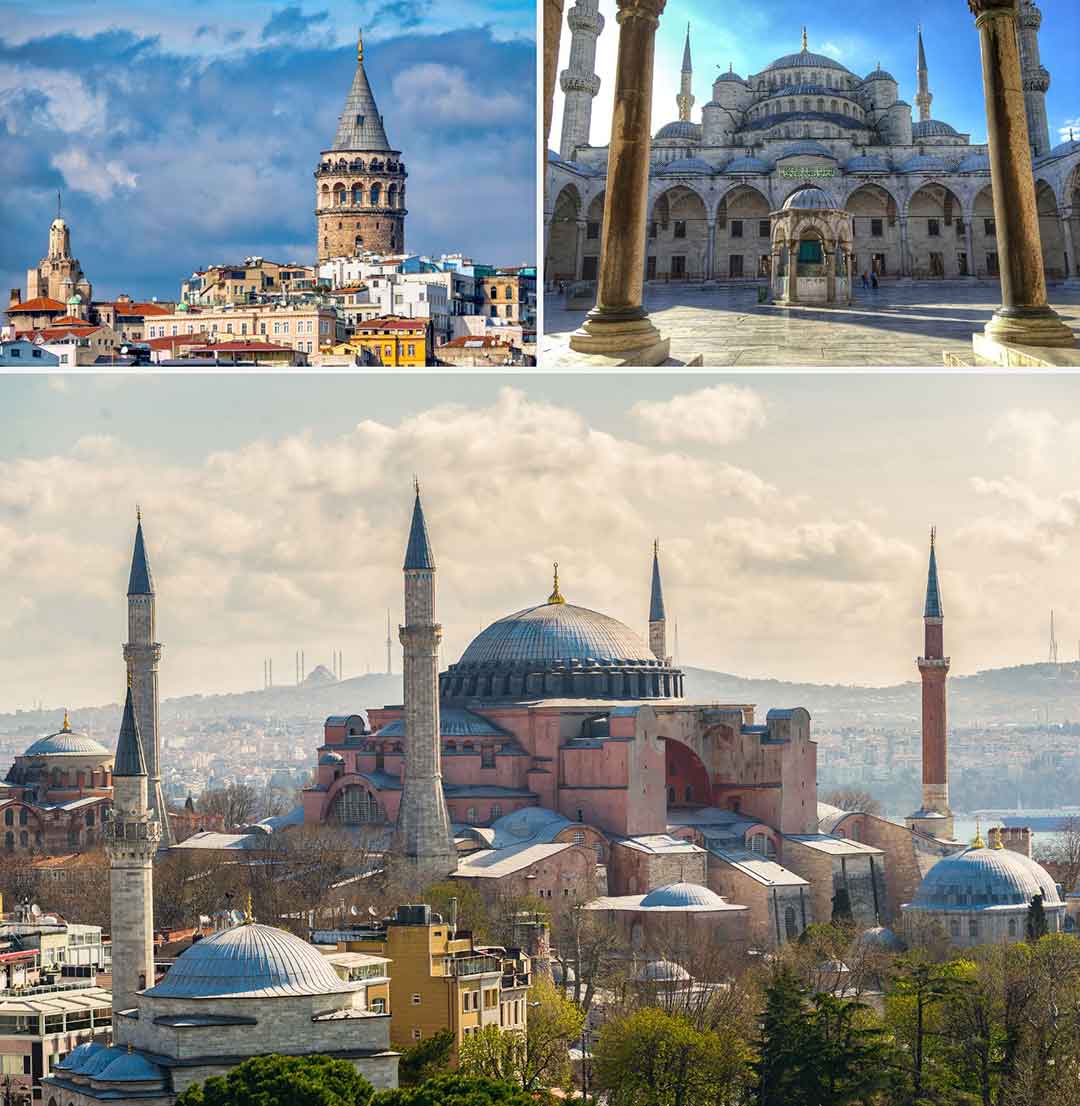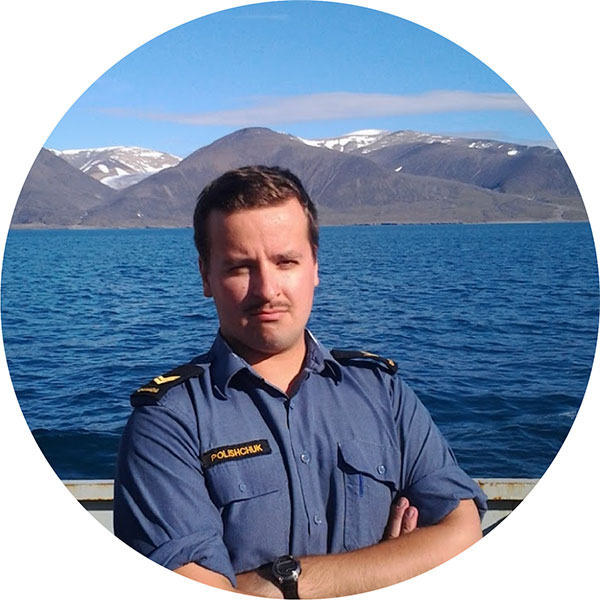Architecture is the practice of designing and constructing buildings and spaces to serve human needs. Architecture is both an art and a science, balancing the principles of physics and functionality with aesthetics and cultural symbolism. The origins of architecture trace back to the dawn of human civilization when people began constructing simple shelters using natural materials like stone, wood, and mud. Architectural practices and theories evolved in response to (and as a reflection of) cultural, religious, and technological advancements.

There are four broad classifications outlining how to describe architecture independent of individual styles: residential, commercial, public, and industrial.
- Residential architecture focuses on creating livable spaces for individuals and families. For example, European row houses balance comfort and functionality for large numbers of inhabitants within limited urban space.
- Commercial architecture creates spaces optimized for commerce. New York City’s Flatiron building is a prime example that makes innovative use of an unusually shaped plot of land to provide centrally located office space while creating a recognizable commercial identity.
- Public architecture curates communal spaces in service of public interest and identity. The Sydney Opera House is an iconic example of Australia’s modern identity and aspirations as a focal point for the arts.
- Industrial architecture focuses on structures that are purpose-built for manufacturing, production, shipping, and storage. The striking art deco Battersea Power Station in London is an example of industrial architecture that transcends its utilitarian goals to elevate the aesthetic of the city it serves.
Each type of architecture has unique priorities for its constructions. However, the broad focus of the discipline encompasses three sets of key characteristics. The first set concentrates on aesthetic elements of shape, line, color, texture, and light to create a cohesive visual experience. The second set focuses on the spatial and structural elements of scale, space, and movement, which determine the functional experience of a work of architecture. The third set of characteristics are the relational elements of symbolism and context, which shape how structures resonate with and reflect the identities of the communities they serve.
Architecture is of profound importance to both individual human psychology as well as societal well-being. Works of architecture not only provide physical shelter and security, but reinforce cultural identity through symbolism of form, scale, and ornamentation. Architecture provides both the impetus and means for communal activity, fostering a sense of belonging and permanence among its patrons. Furthermore, well-designed spaces facilitate positive social and professional interactions, making them a crucial component of daily human experiences.
The intentional construction of dwellings and spaces predates the etymology of the word “architecture”. However, the term derives from the concept of an individual or group who assumes responsibility for planning and executing purpose-built structures. Evidence of this clearly defined role exists in the ancient Greek architektōn, which roughly translates to mean “master builder”.
Indeed, an architect must possess mastery of a broad range of skills in order to effectively manage the complexity of a given construction project. Chief among these skills is an aptitude for conceptualization and problem-solving. The larger functional and symbolic goals of an architectural undertaking must be grounded in reality, so it is incumbent upon the architect to consider how these aims will be achieved in actionable phases. Attention to detail is thus paramount in the field of architecture to ensure the efficiency and safety of the project and end result alike. Good architects tend to be perpetually curious about the latest technical aspects and cultural contexts of their ideas and collaborate with their peers to develop innovative solutions.
Famous architects throughout history have demonstrated the rigorous intellectual qualities outlined above. For example, Imhotep of 2600 BCE Egypt is widely regarded by historians as a polymathic priest, writer, and physician in addition to his attribution as the world’s first recorded formal architect. Similarly, the 1st-century Roman architect Vitruvius demonstrated a systematic approach to architecture with his treatise “De Architectura”, in which he defined the Classical building principles and methods that would profoundly inspire later architects. Chief among these was the Italian humanist Leon Battista Alberti, who authored the seminal Renaissance architectural treatise “De Re Aedificatoria” in 1452. This work reformulated and expanded upon Classical ideals, systematizing the practical and theoretical aspects of architecture according to principles of human-centered design.
Visionary architects of later periods such as the 19th-century French pedagogue Étienne-Louis Boullée would further develop the standard of architecture as an intellectual pursuit. Boullée’s utopian designs embodied the most aspirational Enlightenment ideals of philosophy and society at large. Architectural thought continued to evolve into the 20th century, exemplified by American architect Frank Lloyd Wright. His “organic architecture” concept revealed the potential for human habitation to exist in harmony with its natural environment and proved pivotal within the broader socio-cultural discourse of modern architecture. Wright’s European contemporary, the Swiss architect Charles-Édouard Jeanneret-Gris “Le Corbusier” pursued a similar equilibrium between architecture and humanity itself. Le Corbusier viewed houses as “machines for living in”, prioritizing human dignity and happiness as their main function.
What is the origin of architecture?
The origin of architecture is evident in prehistoric man-made structures from the Lower Paleolithic era. The earliest known evidence of architecture is the Terra Amata site which dates back to 400,000 BCE. The site is located on Mount Boron near Nice, France, and was discovered in 1966 by French archeologist Henry de Lumley. De Lumley theorized that the site comprised a community of animal-skin huts, departing from the caves in which early humans took shelter. De Lumely and his team additionally found evidence of manmade fires and Paleolithic tools, further suggesting that prehistoric humans occupied the area in a long- or short-term capacity. That said, the origins of architecture potentially began much earlier than the Terra Amata. The 2010 publication, 21st Century Anthropology: A Reference Handbook by H. James Birx, discusses the theory that early humans built tree houses or nests earlier than 400,000 BCE similar to modern-day apes such as chimpanzees or orangutans. These nests or tree houses would be basic forms of architecture, built for sleeping and security. However, little evidence exists to support this idea as organic material used to create tree-bound structures would have decayed quickly. As a result, the French site of Terra Amata remains the earliest sign of architecture in human history.
The concept of architecture expanded during the Neolithic period to a closer contemporary understanding of complex engineering. Humans during the Neolithic stopped living in caves and began domesticating plants and animals. This led to growing communities that required long-term structures that could withstand the elements, house resources, and provide spaces to sleep and cook food. Architecture consequently became necessary to human survival and later expressions of religion and spirituality. The oldest known permanent settlement from the Neolithic period is Göbekli Tepe in Turkey. Göbekli Tepe was erected in 9500 BCE and housed people until 8000 BCE when it was abandoned. The site served both a practical purpose of shelter as well as a religious function. Decorative elements such as animal reliefs suggest spiritual symbology, highlighting one of the earliest examples of aesthetics in architecture. Göbekli Tepe therefore indicates that aesthetics became a part of architecture as early as 9500 BCE.
Aesthetics likely became a part of manmade structures because they express and evoke human experiences and emotions, as captured by the decorative and spiritual elements of Göbekli Tepe. Aesthetics became more elaborate and significant as architecture developed throughout antiquity and human engineering advanced to facilitate larger projects. For instance, the execution of architecture was paramount to the development of Mesopotamian civilizations as they required infrastructure to not only house large populations but to articulate religious or royal importance. Megastructures like Mesopotamian ziggurats were a feat of ancient human ingenuity as well as an example of religious fervor as they functioned as places of worship. Later civilizations in antiquity continued this trend, combining function with architectural aesthetics and symbolism to develop cities and culturally significant structures. The Ancient Egyptian civilization is an example of this as they erected cities and built notable sites like the Giza Pyramid complex and the Step Pyramid of Djoser to house their growing populations and deify their leaders. The latter example, the Pyramid of Djoser, was built by a deified figure and the first-named architect in history, the physician Imhotep.
Imhotep is significant as few architects in antiquity were ever named because architecture was indistinguishable from stone masonry and carpentry. Moreover, architecture was a collaborative effort, and rulers are typically credited with commissioning a structure. The origin of architecture as a career did not emerge until as late as the 18th century wherein an occupational separation was necessary to develop greater feats of engineering and design. The origins of architecture as a concept and as an occupation have since expanded to compensate for the exponential growth of humanity across centuries. Architecture continues to function as a practical necessity by which humans have warmth and shelter, as well as a professional endeavor to evoke human emotion and artistic expression through the architect’s creative mission. Modern architecture is consequently a diverse field that poses distinct challenges, opportunities, and even myths that are unique to the art of building design.
There are three myths associated with architecture. Firstly, the idea that excellent drawing skills are necessary to be an architect is a common myth. Architects indeed utilize their artistic senses to design a structure, but the purpose of drawing in architecture is more functional than creative as architects need to logically communicate their ideas to others. Furthermore, architects rely on other skills beyond drawing, such as math, networking, and collaboration to complete their projects. Secondly, it’s a myth that architects work alone. Architecture was historically a collaborative effort of stonemasons and carpenters. This trend continues today as architects typically work in teams alongside engineers, contractors, and clients to develop projects. Finally, it’s a common myth that architecture focuses solely on aesthetics. Architecture is oftentimes artistic and expressive, with designers seeking to convey a specific message or idea through a structure. However, architecture largely prioritizes function over aesthetics as the way humans are able to interact, navigate, and experience a building affects the success of a structure more than its visual experience does.
What is the etymology of the word Architecture?
The etymology of the word “architecture” has its roots in the Greek word ἀρχιτέκτων or architéktōn. Architéktōn breaks down into two parts archi (start, govern, lead) and tékton (builder, mason), which together roughly translate to “chief builder”. The Latin word architectus derives from the Greek, and has a similar meaning of “architect”. Architectus shares a root with the Latin architectura, providing the etymological stem for modern translations like the Spanish arquitectura, the German Architektur, and the French architecture. The Anglo-Saxons lacked a specific word for architecture prior to the 1066 Norman invasion, so the English word “architecture” is a direct loanword from the French language.
What are the historical eras of architecture?
Below is a list of the historical eras of architecture.
- Paleolithic (400,000 BCE to 10,000 BCE): The Paleolithic era is a prehistoric period where humans did not live in homes or advanced shelters but most likely in nests, huts, and rock shelters. The earliest evidence of a manmade structure is the Terra Amata where archaeologists theorize a beach-side community lived in huts made of animal skin and built domesticated fires. No known architects exist from this era as it predates the written language.
- Neolithic (10,000 BCE to 2,000 BCE): The Neolithic era marks the beginning of more advanced approaches to architecture as humans transitioned from living in rock shelters and began domesticating plants and animals. A notable structure from this era is the Göbekli Tepe site which was erected in 9500 BCE and likely served both a functional and religious purpose. Basic structures of rock, mud, and megaliths additionally characterize Neolithic architecture.
- Mesopotamia (10,000 BCE to 600 BCE): The Mesopotamia historical era groups the architectural efforts of major civilizations who lived in the region of the Tigris–Euphrates river system, such as the Sumerians, Akkadians, Babylonians, and Assyrians. Mesopotamia marks the beginning of major architectural efforts and the development of urban planning. Reliefs, mud bricks, mosaics, and ziggurats characterize this era. One of the most notable buildings from this period is the Ziggurat of Ur which was constructed in 2050 BC by King Ur-Nammu of the Neo-Sumerian Empire as a place of worship.
- Ancient Egypt (3100 BCE to 395 CE): Ancient Egyptian structures are one of the most significant examples of architecture in antiquity due to the advanced engineering and projects that took place. Ancient Egyptian architecture is broadly characterized by architectural elements such as symmetry, symbolism, limestone, papyrus-styled columns, and astronomical alignment. One of the most notable landmarks, the Great Pyramid of Giza, represents these fundamental elements. Additionally, ancient Egypt gave rise to the first named architect in history, the defied physician Imhoptep, who allegedly designed the Pyramid of Djoser in the 27th century BCE.
- Mesoamerica (2000 BCE to 1519 CE): Ancient Mesoamerican architecture encompasses major civilizations such as the Olmec, Mayan, Aztec, and Zapotec peoples. The civilizations bore distinct architectural features according to their region and culture, but we’re able to generalize ancient Mesoamerica through the stepped structures, corbelled arches, flat roots, and mythological iconography that characterize Mesoamerican infrastructure. No records exist of named architects, but Mesoamerica gave rise to many notable structures such as the Pyramid of the Sun and the Moon which were built by the Teotihuacan civilization between 100 AD and 450 AD.
- Classical architecture (700 BCE to 400 CE): Classical architecture groups the structural characteristics of ancient Greece and Rome. Ancient Greek is characterized by the Greek column orders of Doric, Ionic, and Corinthian as well as symmetry and usage of the golden ratio. Two notable architects from Ancient Greece include Ictinus and Callicrates who built the Parthenon. Meanwhile, ancient Roman architecture was influenced by Ancient Greece and was governed by columns, arches, as well as domes, and more advanced developments of aqueducts. A well-known ancient Roman structure is the Colosseum which exemplifies notable qualities of Roman architecture. Another famous architectural example is the Forum, an open-air plaza built by architect Apollodorus of Damascus.
- Byzantine (330 to 1453): The Byzantine time period corresponds to the architecture of the Byzantine Empire, otherwise known as the Eastern Roman Empire. Domes, mosaics, monumental scale, and religious symbolism characterize the era. Byzantine structures additionally took inspiration but gradually became more distinct from Roman architecture. One of the most famous structures from Byzantine is the Hagia Sophia, a church-turned-mosque that was designed by architects Isidore of Miletus and Anthemius of Tralles. The Hagia Sophia exemplifies the peak of Byzantine engineering as well as the time period’s emphasis on grand interiors.
- Romanesque (1050 to 1170 ): Romanesque architecture marks the transition away from broader architectural eras that corresponded to a single region or civilization. Romanesque architecture existed across medieval Europe and is associated with elements like decorative arches, small windows, piers, and towers, as well as barrel, groin, and ribbed vaults. Few named architects are accredited with constructing buildings during this period, though noteworthy structures like the Abbey Church of Saint Foy and the Basilica of Saint-Sernin represent fundamental elements of the time period.
- Gothic (1150 to 1600): The historical era of Gothic architecture corresponds to the High and Late Middle Ages of Europe which emphasized Christian symbolism. Gothic architecture consequently corresponds to religious iconography as well as fundamental features like stained glass windows, monumental scale, flying buttresses, and vertical lines. One of the most famous structures from the time period is the Notre Dame de Paris, which serves as the hallmark of French Gothic architecture, capturing the major architectural elements. The St. Vitus Cathedral is another notable building. It was built by Peter Parler, a famed Gothic architect and descendant of a family of master builders.
- Renaissance (1400 to 1600): The Renaissance era was a European movement spurred by technological and artistic innovation that adapted classical architecture. Consequently, Renaissance architecture is characterized by prominent classical elements, such as symmetry, columns, and domes, as well as heightened religious inspiration, advanced geometry, exaggerated proportions, and the integration of sculpture as an aesthetic quality. The Renaissance period additionally gave rise to many notable architects, including Filippo Brunelleschi, Donato Bramante, and Michelangelo. These architects were responsible for famous structures like St. Peter’s Basilica, which was a collaborative effort of Vatican City’s best artisans.
- Baroque (1600 to 1750): Elaborate and vivacious interiors, ornate details, extensive usage of shadows, large domes, gilded sculptures, and curved shapes characterize the Baroque era of architecture. Baroque succeeded the Renaissance and consequently influenced Europe as a whole, giving rise to opulent structures such as the Palace of Versailles in France and the Karlskirche church in Vienna, Austria. The period is additionally marked by skilled architects who helped guide the movement, including Gian Lorenzo Bernini who defined the Baroque sculptural style, and Louis Le Vau, who was the court architect of Louis XIV of France and worked on the garden of the Palace of Versailles.
- Neoclassical (1750 CE to 1920 CE): The Neoclassical style originates from France and Italy, but it transcended borders and influenced architecture across Europe and Northern America. Neoclassical is additionally one of several architectural eras that took inspiration from Greek and Roman structures, demonstrating simplified forms, minimal details, and symmetrical exteriors. Neoclassical architecture departed from late Baroque opulence to create grand but visually balanced structures such as the Panthéon by architect Jacques-Germain Soufflot or the United States Capitol building by William Thornton. Both buildings convey a sense of order in addition to distinct Greek and Roman architectural elements.
- Victorian (1837 CE to 1901 CE): The Victorian era refers to the architectural style that became predominant during the reign of Queen Victoria of England. The era is distinguished by key characteristics such as steep roofs, iron railings, asymmetrical exteriors, decorative trims, and stained glass windows. Victorian architecture ranges from bright palettes to dark color schemes. Two prominent examples of the historical era include the Painted Ladies of San Francisco and the Carson Mansion in Eureka, California. The latter was designed by the architects Samuel and Joseph Cather Newsom, prominent American architects who contributed to the Victorian movement stateside.
- Art Nouveau (1883 to 1914): The historical era of Art Nouveau was distinguished by a shift toward organic forms, including curved lines and floral or plant-like motifs and decals. Stained glass windows and abstract aesthetics additionally became prominent. The movement began in France and Belgium but spread across Europe and the United States of America. Notable structures inspired by the era include the Casa Batlló, an Art Nouveau building that emphasized natural shapes and whimsical details. The building was developed by Antoni Gaudí, one of the most famous architects in history and designer of the Sagrada Família, another Art Nouveau structure that combines classical Gothic elements to create a unique blend of grandeur and opulence.
- Art Deco (1919 to 1939): Art Deco architecture is characterized by stark geometric shapes, accentuated lines, ambitious feats of engineering such as skyscrapers, and luxurious materials previously unused or underutilized. The structures erected during this period additionally reflected the growing consumerism and industrial pursuits of the United States. Art Deco skyscrapers such as the Empire State Building by the Shreve, Lamb & Harmon firm, and the Chrysler Building by William Van Alen feature sleek lines and decorative elements quintessential to the movement. The skyscrapers additionally embody the era’s focus on modernity and architectural ambition through the innovative usage of steel that gives the buildings their iconic exteriors.
- Modernism (1917 to 1965): Modernism was a historical era of architecture governed by minimalism, flat roots, neutral color palettes, glass, steel, and reinforced concrete. Modernism marked the end of more luxurious and expressive styles such as Art Deco. The era influenced architecture across the Western world, leading to the development of notable structures such as the Villa Savoye by Le Corbusier and Pierre Jeanneret, as well as Fallingwater by Frank Lloyd Wright. These buildings exemplify the departure of ornamentation and the era’s emphasis on functional spaces and simplified forms.
- Postmodernism (1950 to 2007): Postmodernism developed to oppose the minimalism of modernism, employing brighter color palettes and organic shapes while maintaining much of the geometrics of the previous era. The result was experimental designs that emphasized the architect’s artistic vision over functionality. Two examples of postmodern structures include the Portland Building by Michael Graves and the firm, Emery Roth & Sons, as well as the SIS Building by Terry Farrell and Partners. These structures represent the eclectic designs of the era by featuring a mixture of historical references and ornamentation while maintaining the basic geometric elements of modernism.
- Contemporary (2000 and beyond): Contemporary architecture corresponds to present-day architectural movements. Consequently, contemporary architecture is diverse and includes styles such as parametricism, brutalism, deconstructivism, neo-modernism, neo-futurism, and sustainable structures. Additionally, contemporary architecture tends to be governed by experimentalism with notable architects such as Frank Gehry and Norman Foster exploring unconventional forms and shapes in their work. Examples of contemporary buildings include the Copenhagen Opera House in Denmark and the One World Trade Center in New York City, United States. The former illustrates neo-futuristic elements whereas the latter is an example of contemporary modernism.
What are the types of architecture?
The types of architecture are defined and exemplified by the list of twenty-one major architectural styles below.
- Vernacular architecture: Vernacular architecture is ubiquitous throughout world history, and reflects the environmental and cultural needs of the people it houses. Inuit igloos are exemplary of the idiosyncracies of form that such shelters can demand, making use of widely available resources to protect against the harsh arctic environment.
- Classical architecture: The Classical period of architecture emerged in ancient Greece in the 5th century BCE and endured through the Roman Empire. The style’s seminal architect is Vitruvius, whose foundational work “De Architectura” formalized Classical architectural precepts of balance, symmetry, and proportion.
- Gothic architecture: The emergence of the Gothic style in early 12th-century France is widely attributed to Abbot Suger’s ambitious renovation of the choir of the Abbey of Saint-Denis. His use of ribbed vaulting and pointed arches pioneered the characteristic ribbed vaulting and pointed arches that would define later Gothic works such as the Cathedral of Notre Dame in Paris.
- Renaissance architecture: Renaissance architects pursued a return to Classical ideals, elevating platonic notions of form with an updated understanding of depth and symbolism. Michelangelo’s dome on St. Peter’s Basilica in the Vatican exemplifies the technological advancements and cultural prominence characteristic of Renaissance architecture throughout 14th-16th century Europe.
- Baroque architecture: Baroque architecture is a late 16th-century reaction to Renaissance restraint that embraced ornamental opulence in order to foster an emotional reaction. The Italian artist and architect Gian Lorenzo Bernini designed the colonnade of the Piazza San Pietro to represent the “Maternal arms of the mother church” in characteristically Baroque recognizance of the viewer’s role in defining the form and function of architectural works.
- Modern architecture: Modern architecture marked a departure from historical styles beginning in the late 19th to early 20th centuries, focusing on function over form and showcasing new materials like steel and concrete. Le Corbusier’s Villa Savoye in France exemplifies the movement with its streamlined design and the application of his five points of architecture.
- Postmodern architecture: Postmodernism emerged in the 1960s as a reaction to the perceived sterility of modern architecture, reintroducing ornamentation and historical references. Philip Johnson and John Burgee’s AT&T Building (now known as 550 Madison Avenue) in New York, with its Chippendale-inspired top, is a hallmark of the style’s playful engagement with history.
- Deconstructivist architecture: Deconstructivism is characterized by fragmented forms and manipulated structures. Frank Gehry’s Guggenheim Museum in Bilbao, Spain, with its seemingly chaotic metallic curves, embodies this novel 1980s architectural approach.
- Brutalist architecture: Brutalism is a mid-20th-century architectural style known for its raw, unadorned concrete structures. Le Corbusier’s Unité d’Habitation in Marseille represents the style with its emphasis on utilitarian function and repetition of form.
- Parametric architecture: Parametric design utilizes computer algorithms to produce buildings with complex curves and patterns. Zaha Hadid’s Heydar Aliyev Center in Azerbaijan typifies the fluid forms possible through this 21st-century digital approach.
- Residential architecture: Residential architecture caters to private living spaces adapted to cultural and individual needs spanning human history. Frank Lloyd Wright’s 1939 opus Fallingwater in Pennsylvania epitomizes the seamless integration of residence with its surrounding environment.
- Commercial architecture: This modern style emphasizes brand identity due to its focus on commerce and business. The Apple Store on Fifth Avenue in New York, with its innovative glass cube entrance, represents the blend of function and brand recognition.
- Industrial architecture: Architectural design focused on industry conceptualizes large spaces that use functional materials to create a productive environment for manufacturing, storage, and shipping. The Van Nelle Factory in Rotterdam, Netherlands, exemplifies the functional aesthetics of early 20th-century industrial design.
- Institutional architecture: This ubiquitous mode of architecture is tailored for accessibility in establishments like schools and hospitals. Alvar Aalto’s Paimio Sanatorium in Finland is a prime example that prioritizes patient well-being in its design.
- Landscape architecture: This discipline specializes in designing outdoor environments by harmonizing ecological, cultural, and social needs. Frederick Law Olmsted’s design for Central Park in New York, completed in the 1870s, stands as a paragon, merging natural landscapes with urban amenities to provide a multifunctional public space that caters to diverse recreational and communal activities.
- Interior architecture: Interior architecture concentrates on the design of interior spaces with functionality and aesthetics. Charles Rennie Mackintosh’s Willow Tea Rooms in Glasgow, showcasing early 20th-century Art Nouveau design, stands as a testament.
- Sustainable architecture: his approach emphasizes ecological responsibility and efficient resource use in design and construction. Renzo Piano’s Jean-Marie Tjibaou Cultural Centre in New Caledonia showcases this philosophy, employing local materials and passive design techniques to reduce energy consumption, all while celebrating the region’s indigenous Kanak culture.
- Power architecture: Power architecture is designed to project authority and power through large-scale, enduring, culturally salient constructions. The Pentagon in Virginia, built during World War II as the Department of Defense’s headquarters, embodies this concept through its massive scale and imposing structured form.
- Group housing architecture: The goal of group housing architecture is to optimize shared spaces in order to foster community actions while preserving resources. Moshe Safdie’s Habitat 67 in Montreal is emblematic of this style, with its interconnected concrete boxes offering both private and communal spaces in a radical reimagining of urban living solutions.
- Religious architecture: Religious architecture evolved over millennia and serves as a testament to mankind’s diverse spiritual expressions and preoccupations. The Sagrada Família in Barcelona, designed by Antoni Gaudí in 1882, encapsulates this with its intricate facades and towers that marry Gothic and Art Nouveau forms in homage to Christian motifs.
- Governmental architecture: These structures symbolize state power and civic functions. Sir Edwin Lutyens’ design of the Rashtrapati Bhavan (Presidential Residence) in New Delhi embodies this, melding traditional Indian and British architectural elements, representing the colonial era and its influences on India’s urban fabric.
The above is not an exhaustive list of all possible architectural styles, modes, and classifications. Other important and influential styles contribute to the broader architectural discourse, namely Romanesque, Expressionist, Organic, Tropical, and Futurist architecture. However, for the sake of brevity and clarity, we focus on the 21 most widely impactful types of architecture in greater detail below.
1. Vernacular architecture
Vernacular architecture is a traditional, pragmatic approach to building human habitation that predates any formal school of architecture. Vernacular architecture essentially exists to serve specific cultural or environmental needs and typically makes use of materials that are locally abundant. Examples of vernacular architecture are as varied as the cultures they represent and abound from the dawn of civilization up through the preindustrial era. The pueblos blancos of Andalusia bear a distinctive slaked lime whitewashing that not only serves as natural cooling amidst intense Spanish summers but stands testament to the ingenuity of Moorish architects who made use of this material’s disinfectant properties to combat the spread of cholera. Similarly, the native Inuit built igloos from locally harvested icebrick to retain heat amidst the harsh arctic climate. Vernacular architecture is of profound historical importance, as it provides intimate insights into the traditions, values, means, and contexts of a given culture.
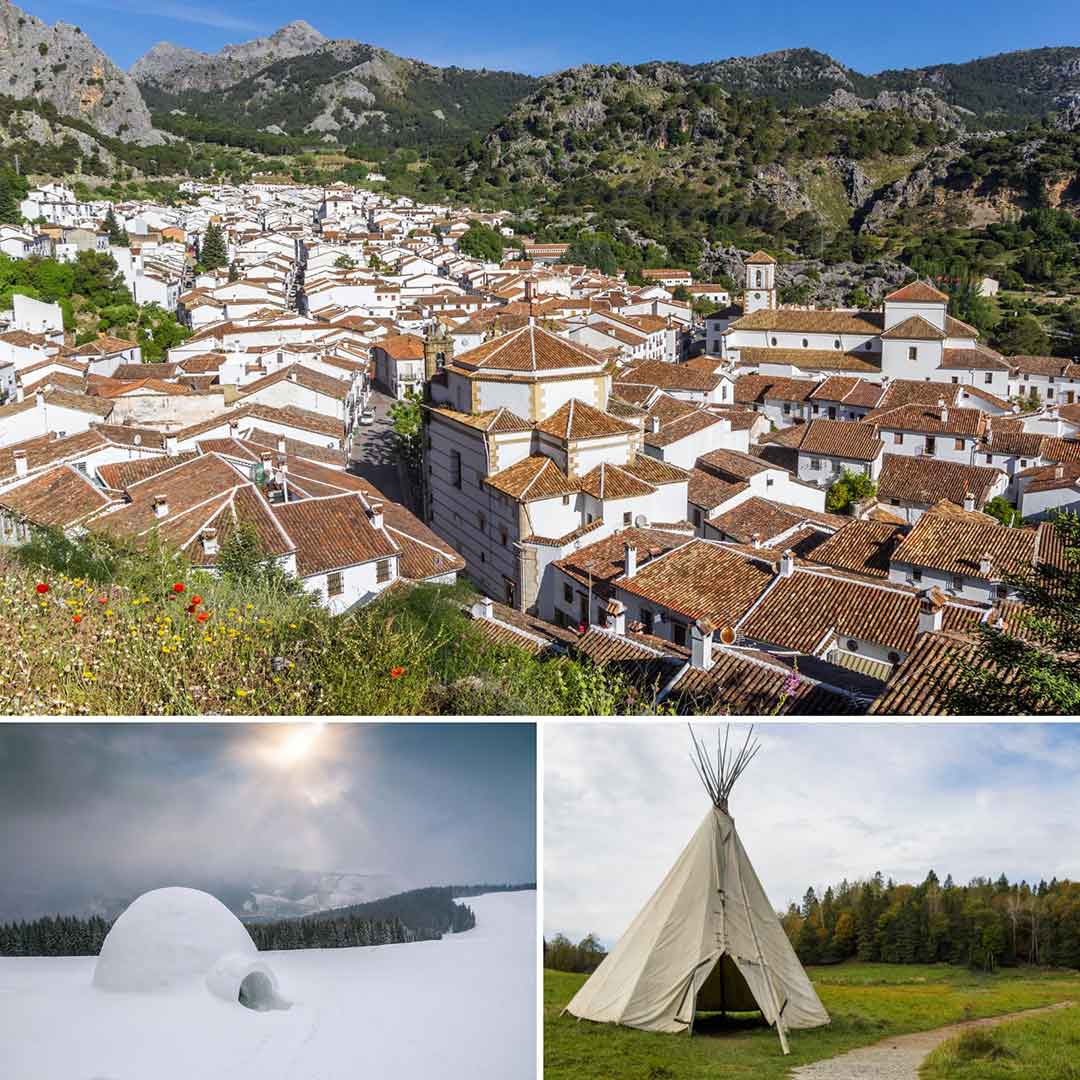
Virtually every nation on earth has some tradition of vernacular architecture, however, every example tends to share three general characteristics. First, vernacular buildings make use of readily available materials. Pre-industrial civilizations tended to use natural materials, however more modern examples of vernacular architecture like East German plattenbauten feature economically advantageous resources like concrete. Second, vernacular architecture provides specific environmental advantages. The thatched-roof houses of the British Isles, for example, offer substantial waterproofing and resilience against heavy wind. Finally, buildings in the vernacular style tend to reflect the cultural traditions of their builders. For example, the rumah gadang of West Sumatra features a curved roof resembling water buffalo horns, an allusion to the Minangkabau legend from which the native inhabitants derive their name.
2. Classical architecture
Classical architecture is a building style rooted in the traditions and principles of ancient Greece and Rome, emphasizing balance, symmetry, and proportion of form. There are three main orders within Classical architecture that serve as design templates constraining a building’s proportions, details, and decorative elements. The first and oldest order is Doric, characterized by fluted columns that sit directly on the floor without a base–usually present within Greek temples. The second order is Ionic, wherein more slender columns stand on a base and are topped with a scrolled design called a volute. The third and most ornate order is Corinthian, which retained the slender Ionic column design but further adorned the tops with acanthus leaves. The most famous example of classical architecture is the Parthenon in Athens, Greece, which was built in the 5th century BCE as a monument to the goddess Athena and featured Doric columns and elegant pediment sculptures.
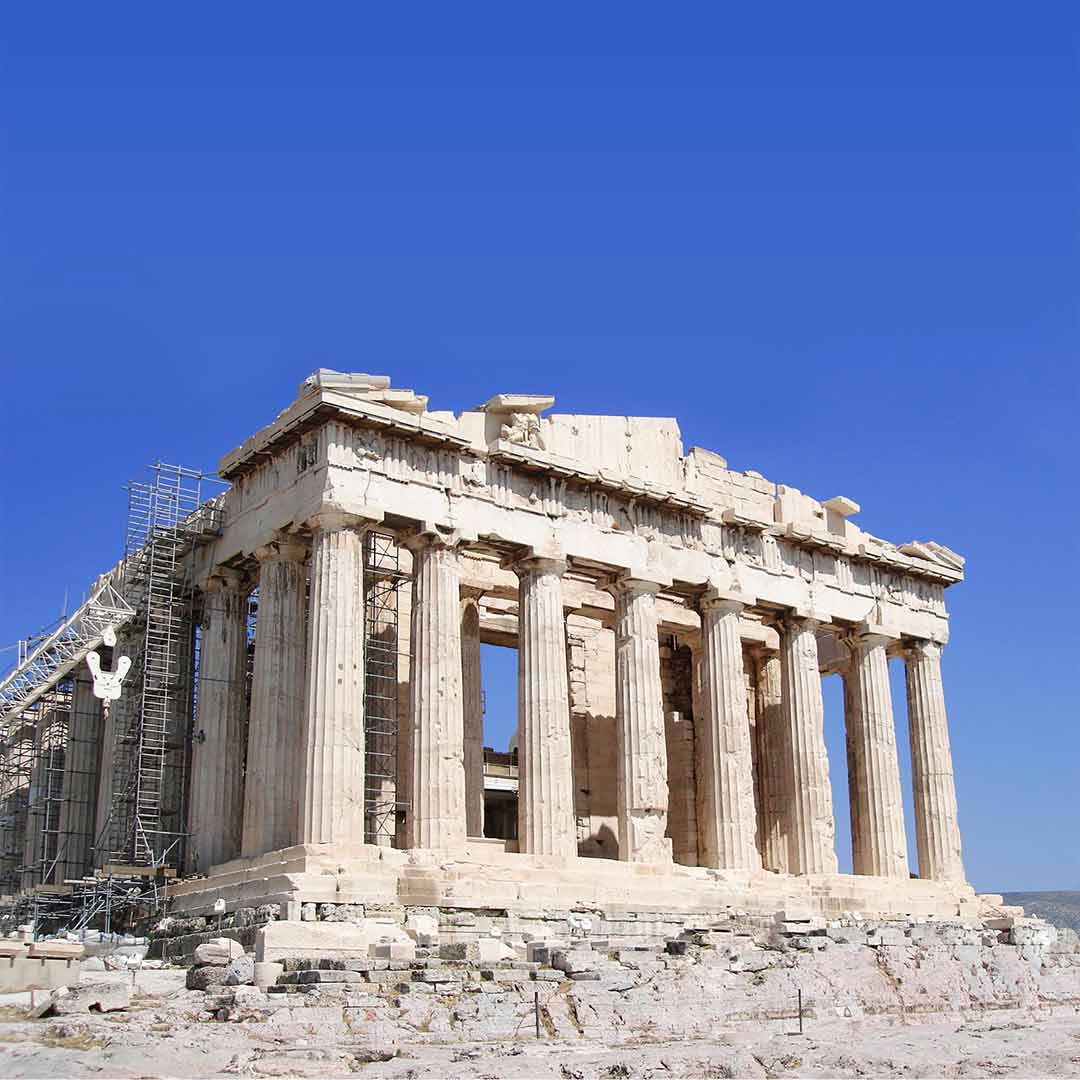
Classical architecture’s importance to Western architecture is immense because it provided a platonic conceptual basis for form and function. Later styles of architecture used Classical precepts as a frame of reference, whether in reaction (like Gothic or Baroque) or in revival (like Renaissance and Neoclassical). Classical architecture dates back to the 7th century BCE in ancient Greece but remains a relevant cultural touchstone and point of study for modern architecture. Modern Western buildings such as the US Supreme Court in Washington DC and the British Museum Reading Room in London reflect classical influences with their domed roofs, columnar construction, and extensive use of marble and stone.
3. Gothic architecture
Gothic architecture is a style originating in Medieval Europe primarily used in the design of religious buildings like Christian cathedrals and churches. Gothic architecture makes intentional use of high-rising features designed to direct the viewer’s gaze up towards the heavens. There are three main characteristics that constitute Gothic’s aspirational nature. The first characteristic is the enhanced structural support afforded by ribbed vaults, flying buttresses, and pointed arches, which allow Gothic buildings to reach towering heights without overly thick walls. Second are the characteristic stone grotesques, which functioned as waterspouts by also served as a symbolic reminder of the dangers of secularism. The third main characteristic is large stained glass windows, which depict religious iconography and allow light to fill the upper vaults with heavenly light.
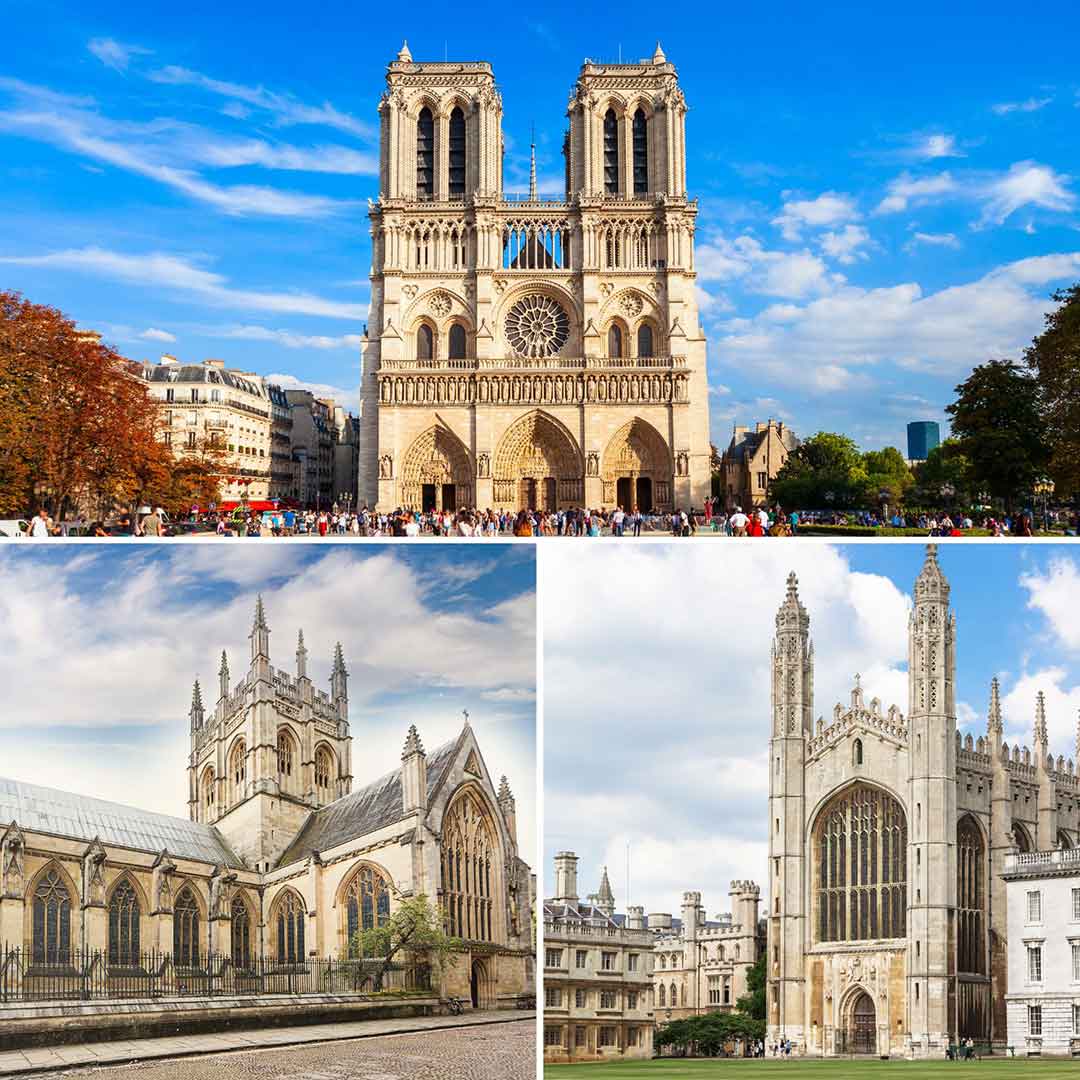
The most famous example of Gothic architecture is the Cathedral of Notre Dame in Paris, France. The cathedral’s intricately sculpted doorways, circular rose windows, slender vertical lines, as well as its gargoyles and chimeras all exemplify both early and High Gothic styling typical of the 12th century. Gothic architecture spread beyond France throughout Europe as an expression of cultural identity, religious piety, scholarship, and artistic sophistication. The Gothic stylings of many buildings within the campuses of Oxford and Cambridge stand as a testament to the formative ties between academia and the church.
4. Renaissance architecture
Renaissance architecture represents a revival of Classical principles like proportion, symmetry, and balance. However, Renaissance architects were less constrained by technological building limitations or strict adherence to Classical orders than their historical influences. The dome of St. Peter’s Basilica in Vatican City is the most famous example of a Renaissance evolution in Classical architecture. Three primary characteristics separate Michelangelo’s masterpiece from its Greco-Roman predecessors. First is the sheer size and height of the dome; although it is of a similar diameter to the Roman Pantheon, its innovative double-shell construction allows it to rise to far greater heights without compromising integrity. Second, Renaissance buildings were more ambitious with their decorative elements, as evidenced by the Basilica’s intricate ribs. Third, Renaissance architects often made use of Classical elements to heighten the symbolic importance of their works; Michelangelo designed the Basilica’s dome lantern as a shining beacon of Christendom.
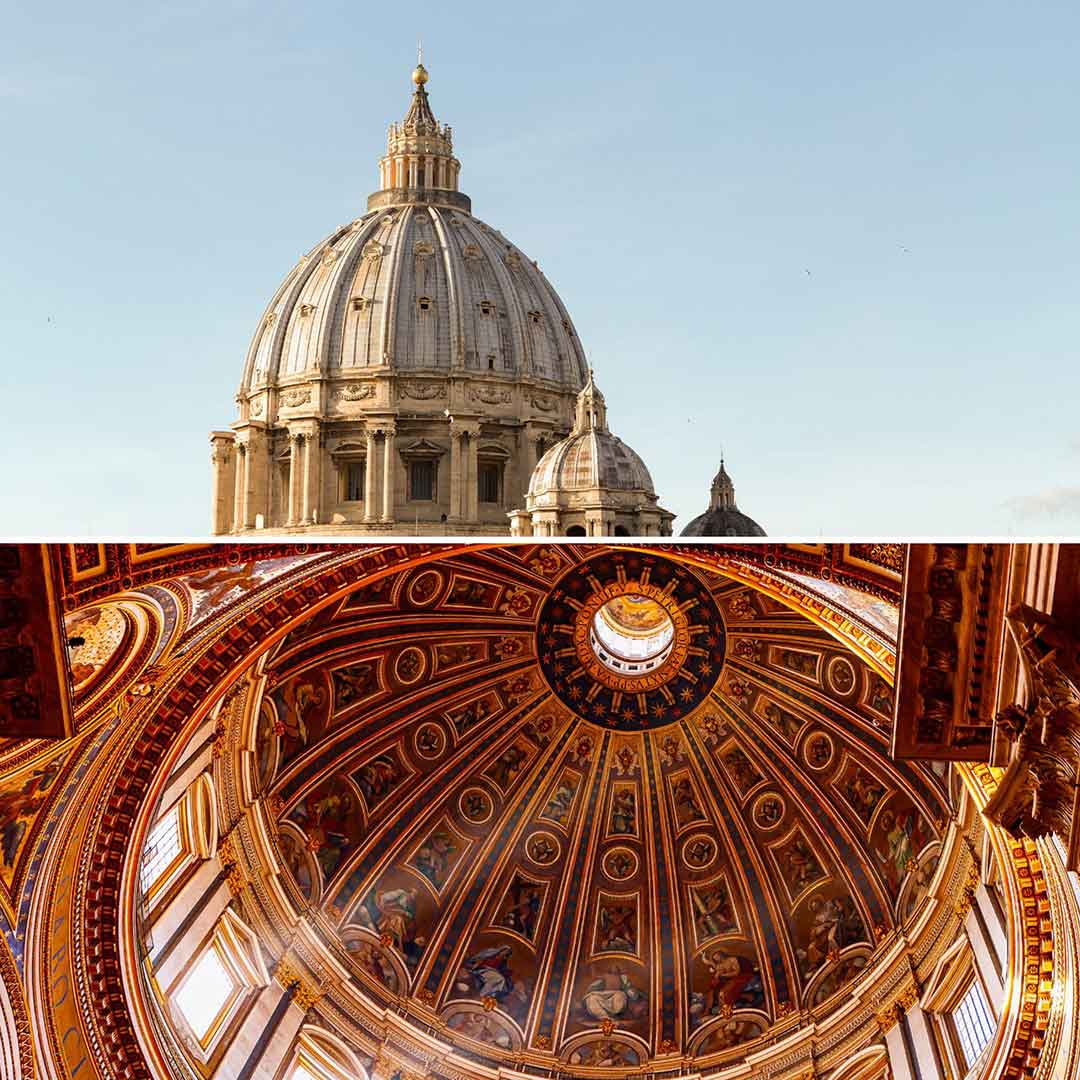
Renaissance architecture spread from 14th-century Italy widely throughout Europe into the early 1600s. Its influence brought a profound shift in cultural values away from medievalism and into the Enlightenment era. The movement’s renewed focus on Classical principles encouraged the standardization of architectural practice, laying the groundwork for the profession as it is understood today. One of the most influential Renaissance treatises was Leon Battista Alberti’s 15th-century work “De Re Aedificatoria”, a collection of 10 books providing instruction for urban planning, material usage, as well as theoretical and practical aspects of architecture derived from ancient Rome.
5. Baroque architecture
Baroque architecture is a highly ornate style of late 16th-century European architecture that emerged as a reaction to the platonic simplicity of Renaissance architecture. There are three primary characteristics that convey the Baroque period’s evocative impetus. Firstly, Baroque architecture makes ample use of opulent ornamentation such as gold leaf, shell motifs, garlands, drapery, cherubs, and vivid frescoes in order to evoke a sense of splendor. Second, Baroque structures undulate and curve in a dynamic way to create the illusion of movement and energy. The third characteristic is the express intention to make an emotional impact on the viewer, especially in religious contexts to bolster the preeminence of the Church. The Church of Sant’Agnese in Agone in Rome is emblematic of the Baroque style with its dynamic facades, sculpted vaults, and a dome that gives the illusion of floating amidst light-filled windows.
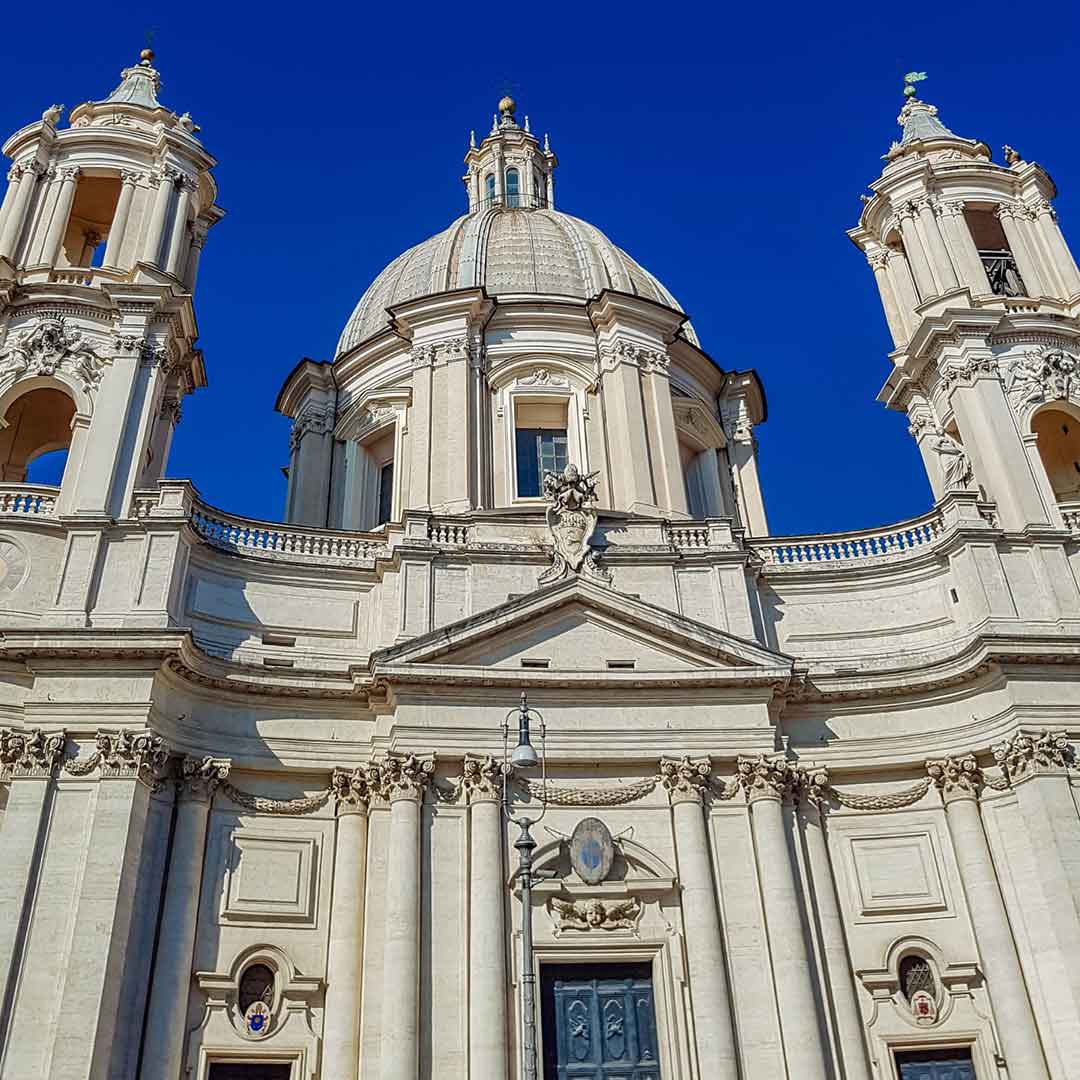
The legacy of the Baroque period is in how it intermixed artistic disciplines. Architects of the day worked hand-in-hand with sculptors and artists to create a holistic transcendental experience. Moreover, the push for decadence prompted profound experimentation with the spatial precepts revived by Renaissance thinkers, further establishing architecture not only as a profession but as an art form unto itself. Baroque architecture represents an evolution of human-centric enlightenment values in how it foregrounded the human experience of a given work.
6. Modern architecture
Modern architecture is an architectural style that utilizes clean lines and minimalist design to emphasize functionality over ornamentalism. The modern architecture, or modernist, movement began in the late 19th century with a revolution in building and design techniques and continued into the 20th century. For example, modernist architecture capitalized on a combination of newer materials and technologies, such as cast iron, drywall, plate glass, and reinforced concrete, to push the limits of architecture and create unique sturdy buildings. The Palácio do Planalto in Brazil, designed by Oscar Niemeyer, exhibits key features of modern architecture. For example, the Palácio do Planalto boasts white marble columns that support a flat concrete roof with vertical glass surrounding the façade. The modernist design is an important historical advancement in architecture because it embraced revolutionary building techniques and offered a solution to growing urban spaces.
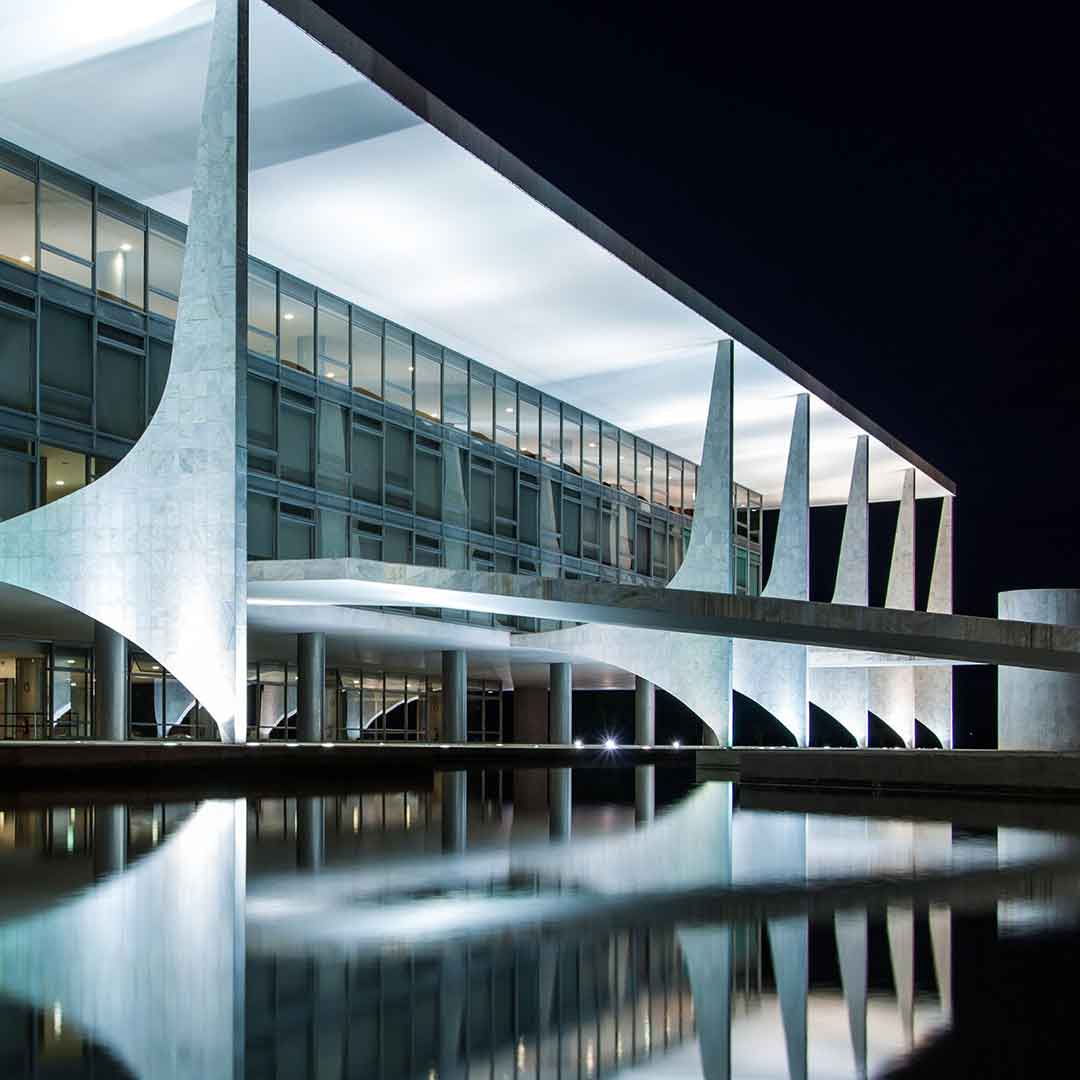
Modern architecture has three main characteristics. Firstly, modern architecture follows functionality over ornamental designs. The Villa Savoye in Poissy, France, designed by Le Corbusier and Pierre Jeanneret, is a textbook example of modern architecture’s focus on minimalism and function. The Villa Savoye features a floor plan devoid of load-bearing walls, which allows for flexibility in wall placement and a free-flowing layout. Secondly, modern architecture is characteristically innovative with traditional building materials. Fallingwater is a modern architectural design in Stewart Township, Pennsylvania, by Frank Lloyd Wright that exemplifies the innovative qualities that define modern architecture. Fallingwater’s modern design utilizes stone, concrete, steel, glass, and wood to create an organic aesthetic that blends into the natural waterfall and surroundings of the home. Thirdly, modern architecture is characterized by integrating with nature. The Farnsworth House by Ludwig Mies van der Rohe in Plano, Illinois, showcases the harmony between modern architecture and nature through 360-degree views of the surrounding floodplain. The clean parallel lines of the house flow with the nearby river, and the interior views allow for a near-total submersion into the natural setting beyond the tall glass windows.
7. Postmodern architecture
Postmodern architecture is an architectural style that diverges from the strict rationality of modernism to incorporate playful, eclectic, and ironic elements. Postmodern architecture emerged in the later half of the 20th century as a response to the perceived emptiness and lack of liveliness in modernist architecture. The theme of postmodernism is to have visually appealing and playful structures that stray from minimalist design. Postmodern architects aimed to communicate with users and visitors through a mix of historical elements and eclectically using new materials. For example, the SIS Building in London, designed as the headquarters for the British Secret Intelligence Service by Terry Farrell and Partners, breaks away from the stark modernist box and features symmetrical curvatures and a mix of concrete and glass plateaus. The SIS building’s complex design resembles ancient Babylonian ziggurats, which earned it the nicknames of the Ziggurat and Babylon-on-Thames. Postmodern architecture is historically important because it challenges the norms of architectural thinking and reintroduces ornamentalism, humor, and cultural connection to design.
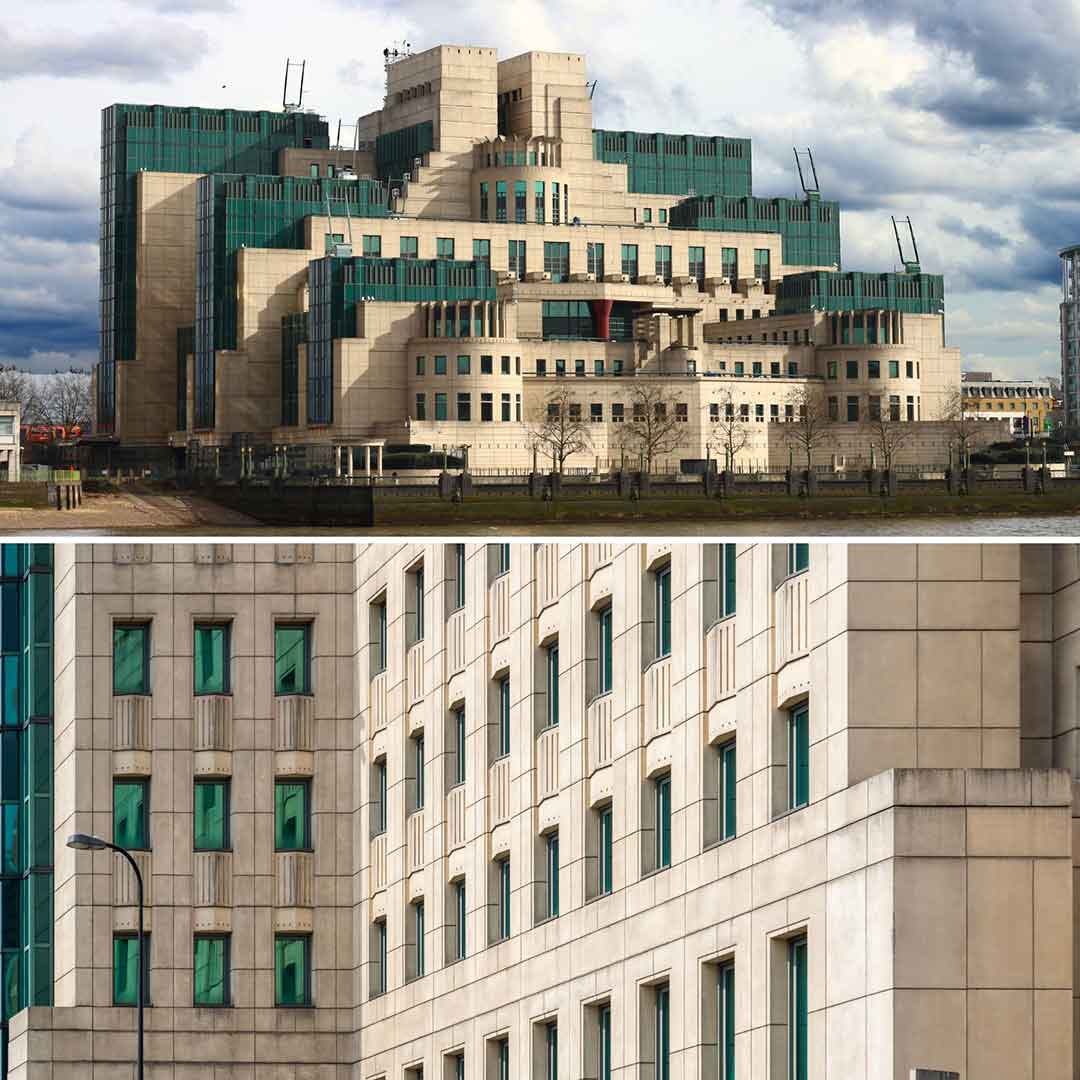
Postmodern architecture has three defining characteristics. Firstly, modern architecture includes a mix of historic and contemporary motifs that exude whimsy. 550 Madison Avenue in New York City, designed by Philip Johnson and John Burgee, encapsulates the blending of styles and whimsical design with its Chippendale-inspired broken pediment, an ornate gesture atop an otherwise modern skyscraper. Secondly, postmodern architecture prioritizes symbolism and design over pure function. Piazza D’Italia in New Orleans, designed by Charles Moore, showcases classical elements like columns and arches, but in an abstract and fragmented manner. Thirdly, postmodern architecture is colorful and incorporates varying textures. The Portland Building in Portland, Oregon, designed by Michael Graves, exemplifies the vibrancy of postmodern architecture with blue tiles and salmon-pink stucco. The mixture of colors and materials brings the structure to life amongst the backdrop of otherwise modern and commercial buildings.
8. Deconstructive architecture
Deconstructive architecture is a style of architecture that uses distorted lines, angles, and planes to manipulate the structure’s continuity. Deconstructive architecture emphasizes asymmetry and features a single material to construct large spaces. The emergence of deconstructive architecture took place in the late 20th century and lasted until the early 21st century. For example, the Guggenheim Museum Bilbao constructed in 1997 by Frank Gehry, showcases the deconstructive architectural features of fragmented design constructed from titanium that bends in varying directions. The sense of unpredictability and controlled chaos in the Guggenheim Museum Bilbao challenges the norm of architecture and emphasizes the evolving urban environment. Deconstructive architecture is an important contribution to architectural history because it encourages architects to question the accepted conventions and embrace ambiguity. Deconstructivism brought a new way of perceiving and interacting with spaces to the forefront of design by breaking the rules of traditional architecture.
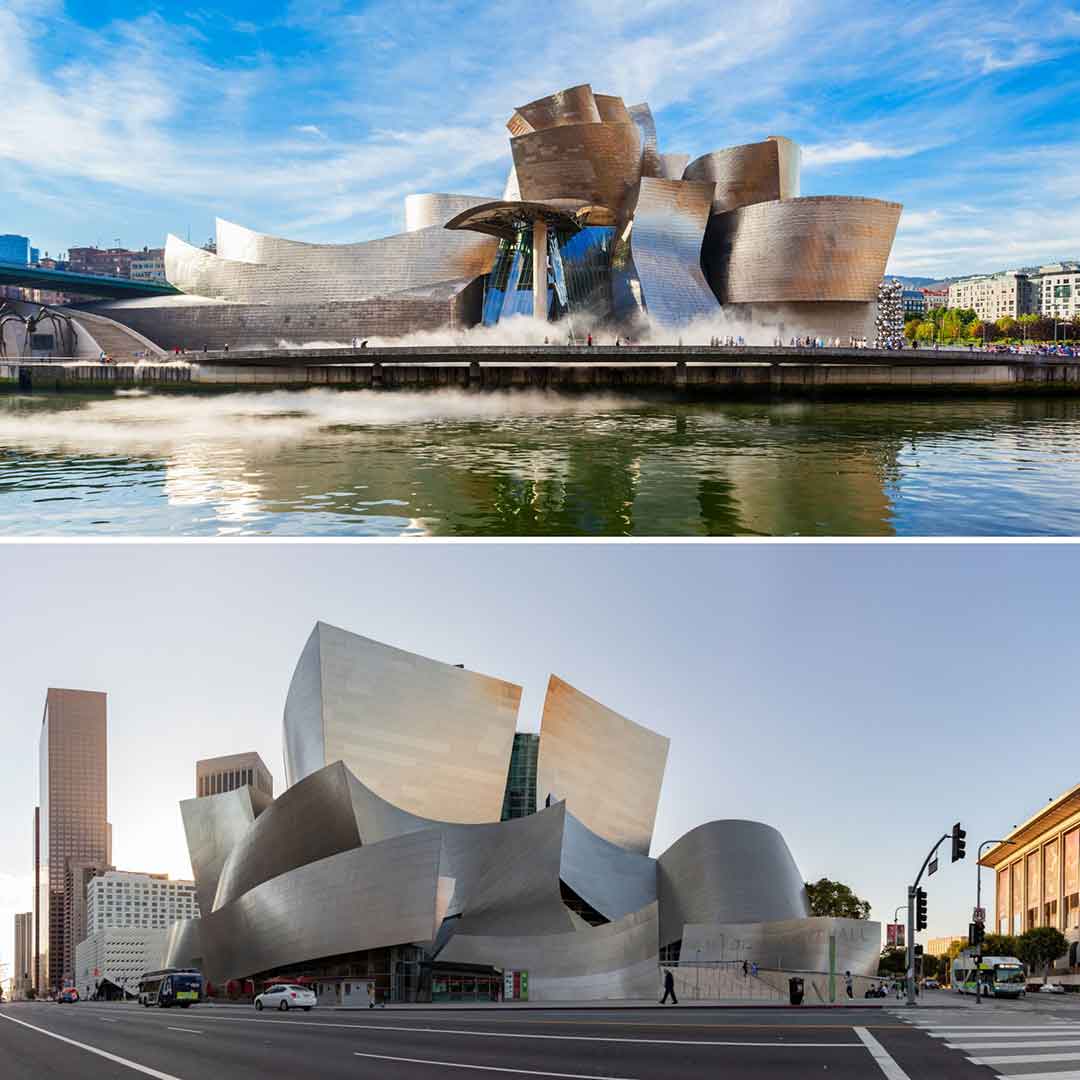
Three main characteristics encapsulate deconstructive architecture. Firstly, deconstructivism often focuses on deconstructing light, space, and material to produce an emotional response. The Jewish Museum in Berlin, designed by Daniel Libeskind, displays the disjointed elements of deconstructive architecture. The frantic zig-zag design and irregular voids symbolize the tumultuous journey of the Jewish people and the void left behind by those lost in the Holocaust. Secondly, deconstructive architectural buildings use a mix of distorted lines and planes to disrupt traditional forms. The Walt Disney Concert Hall in Los Angeles, by Frank Gehry, is a prominent architectural feat that embraces dynamic disruption, controlled complexity, and slanted surfaces. Thirdly, deconstructive architecture creates a sense of movement or instability in static structures. The City of Capitals in Moscow, Russia, by the NBBJ architecture firm, consists of multifaceted angular towers representing the cities of Moscow and Saint Petersburg. The City of Capitals challenges the viewer’s perception of stability through disjointed building segments that appear to be in rotation.
9. Brutalist architecture
Brutalist architecture is an architectural style that uses exposed concrete to evoke a strong yet simplistic aesthetic. Brutalist architecture focuses on strong geometric shapes and exteriors that resemble a fortress of minimalist construction. The emergence of brutalist architecture began in the 20th century during the 1950s and 1960s to tone down the ornamentalism of previous years. For example, the Royal National Theatre in London by Denys Lasdun is a paradigm of brutalist architecture. The Royal National Theatre displays exposed concrete, uneven angles, and geometrical patterns. The vast block-like shape of the Royal National Theatre suggests a modular quality that defines the functional zones of the structure, including three separate theaters. Brutalist architecture is historically significant for inspiring the reconstruction of buildings after World War II. The brutalist architectural style carved its niche in the history of evolving architectural styles as a testament to the beauty of raw, unadorned functionality.
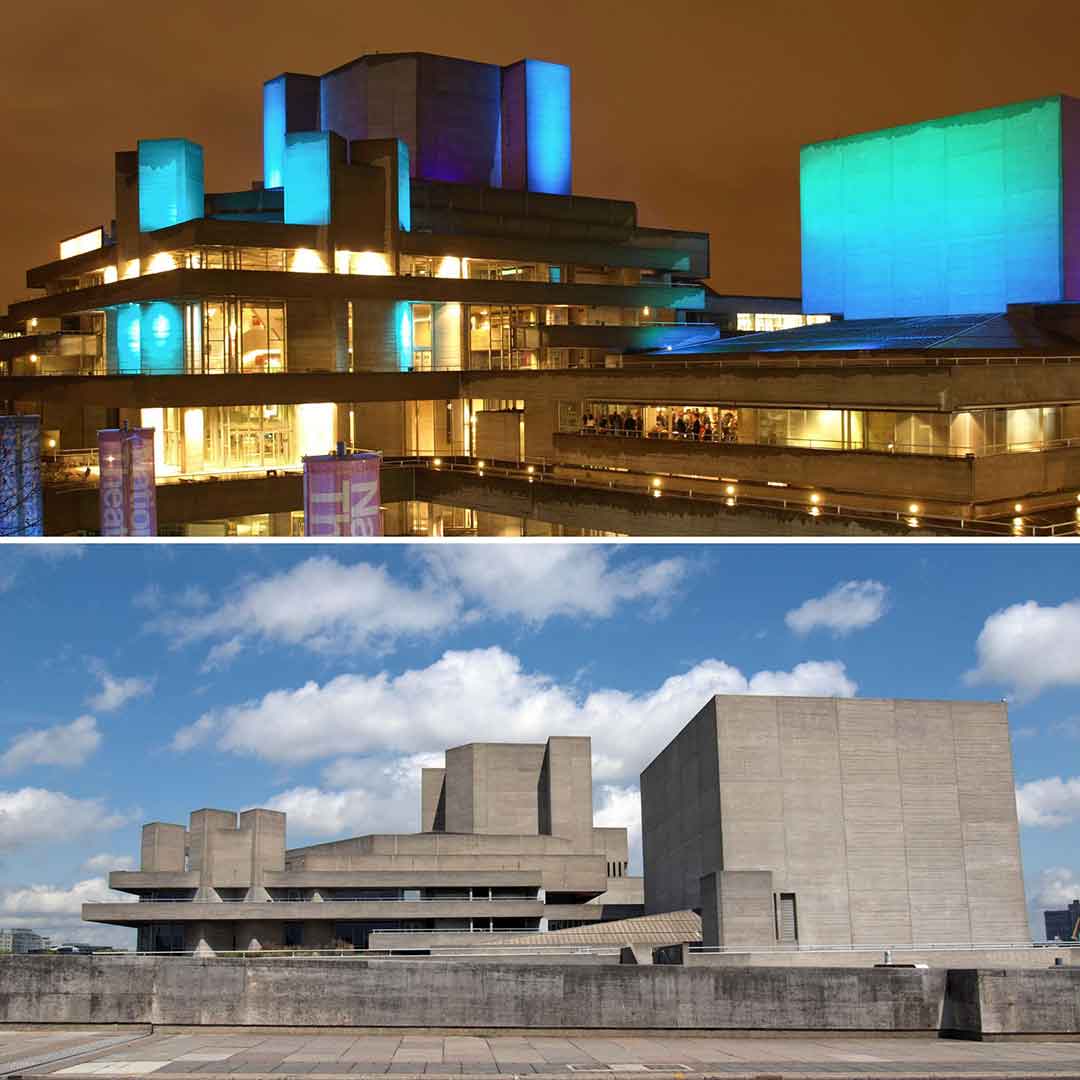
There are three primary characteristics of brutalist architecture. Firstly, brutalist architecture showcases the unyielding presence of exposed concrete as a hallmark design. The Boston City Hall in the United States demonstrates the use of raw concrete due to its façade featuring the coarse material. Secondly, brutalist structures exude a fortress-like presence emphasizing security and stability. The Barbican Centre designed by Chamberlin, Powell, and Bon in London is a testament to the sturdy exterior common among brutalist architecture. The Barbican Centre features a structured flow of compartmental units that creates balance. Thirdly, brutalism focuses on bold geometric shapes. Habitat 67 by Moshe Safdie in Montreal encapsulates an intricate arrangement of concrete cubes that play with form and space. Habitat 67 creates a modular stronghold against the backdrop of a lively Montreal.
10. Parametric architecture
Parametric architecture is a modern style of creating structures with dynamic, intricate, and adaptable features. Parametric architects use mathematical formulas and parameters to produce detailed and unconventional forms of geometries. The parametric style of architecture replicates mirroring patterns observed in nature using algorithms and mathematical parameters. Parametric architecture is a relatively new form of architecture, and gained traction in the late 20th and early 21st centuries. For example, The Peak, created by Studio Symbiosis, showcases the dynamic quality of parametric architecture. The architects highlight the Peak’s functionality through parametric methods to improve ventilation, shading, and energy efficiency. The patterns of the Peak are influenced by nature and use hexagonal patterns that are found in beehives. Parametric architecture is significant to architectural history because the design uses sustainability and innovative ways to create a structure. Parametric architecture seeks to bridge the gap between nature, mathematics, and technology to feature the most efficient design elements.
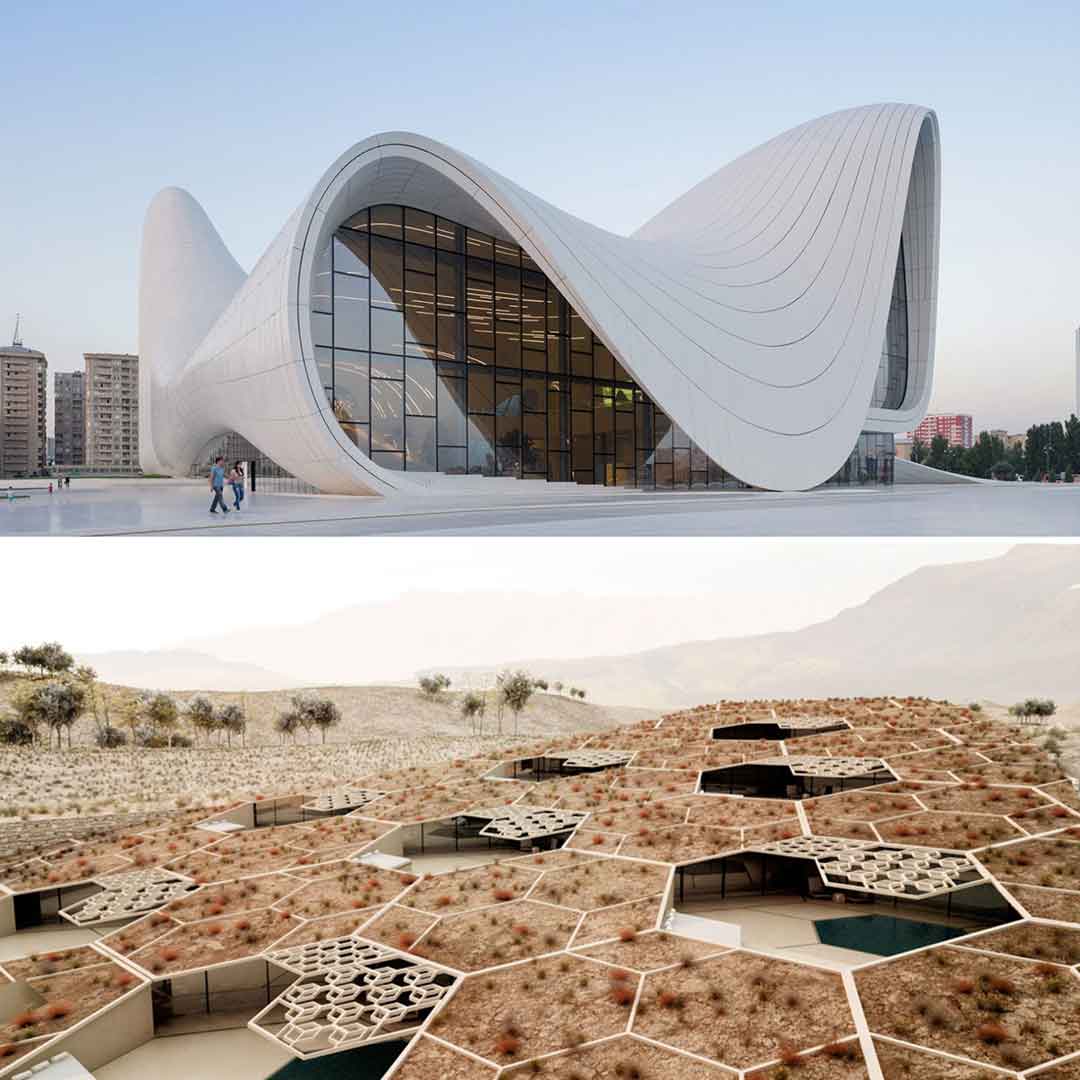
Parametric architecture uses innovative designs and technology to create amazing structures. Parametric architecture structures share three distinct characteristics. Firstly, the parametric architecture uses unconventional forms of geometry in its design. The Heydar Aliyev Center by Zaha Hadid, in Azerbaijan, has an unconventional layout and a smooth and curvy design. Secondly, the parametric architecture uses intrinsic patterns that are inspired by nature. The Beijing National Aquatics Centre in China resembles an image of a cube made out of water molecules. The bubbly façade features a formation strategically designed to catch and reuse water, adding to its functionality and natural essence. Thirdly, parametric architecture is technologically advanced and uses innovative methods to serve its purpose. The Al Bahar Towers in Abu Dhabi uses sun shades that open and close depending on the sunlight conditions. The result is a merging of aesthetic design and functionality.
11. Residential architecture
Residential architecture is a broad term encompassing a range of planned housing projects for individuals, families, or communities. Such projects balance the functional and aesthetic needs of their occupants in order to create comfortable, harmonious living spaces. The ethos of residential architecture has existed as long as humanity has built housing for itself. For example, early Mesopotamians from the Ubaid period (6500-3800 BCE) constructed simple mud-brick homes specifically for housing commoners. However, residential architecture as a formal study is a relatively modern phenomenon, emerging as a facet of academic architectural theory in the 19th century. Institutions like the École des Beaux-Arts in Paris were pivotal in categorizing distinct fields of architecture in response to rapid industrial urbanization.
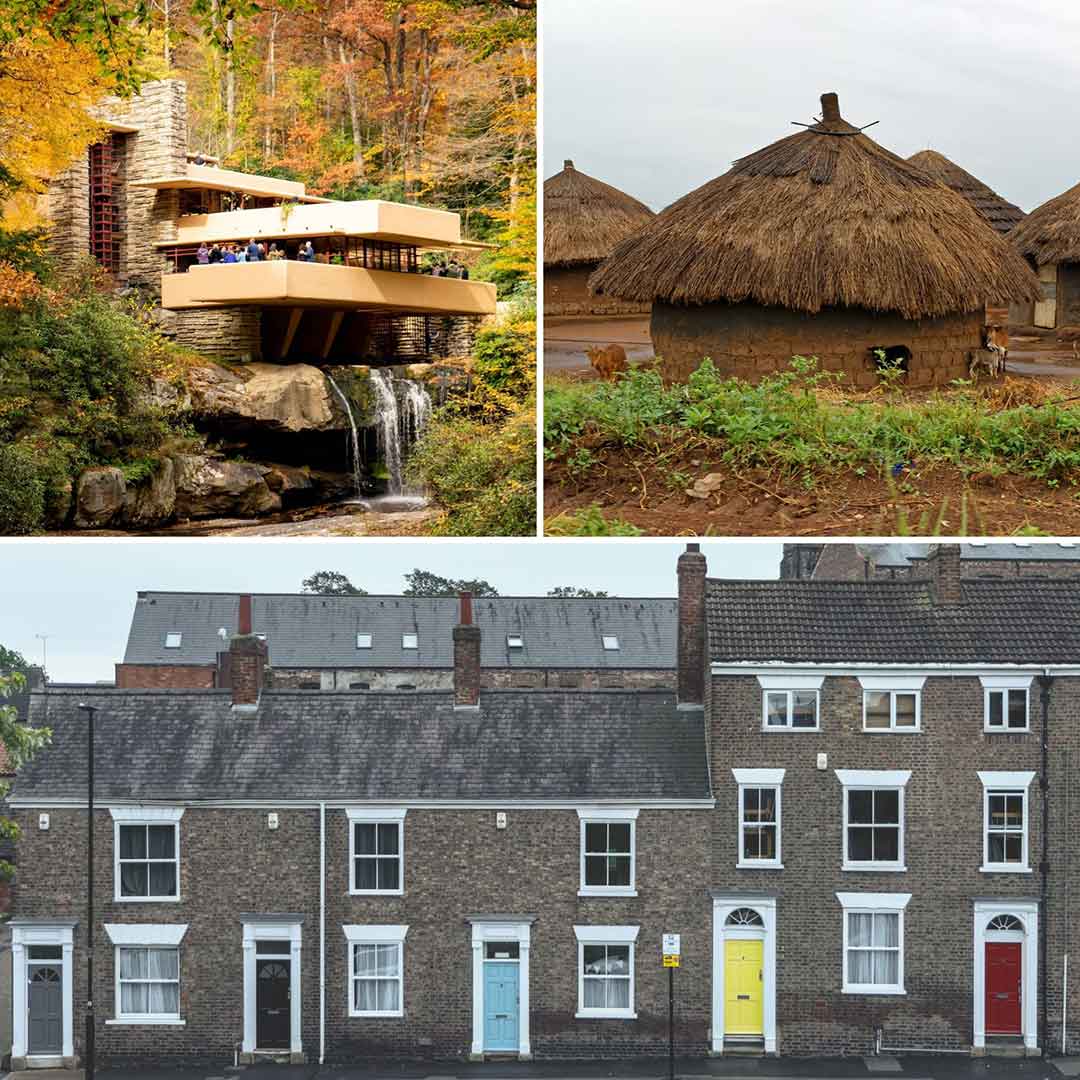
One of the most iconic examples of residential architecture is Frank Lloyd Wright’s Fallingwater, constructed in 1937. Wright designed it to challenge traditional notions of residential architecture as purely utilitarian, demonstrating how human habitation could harmoniously coexist with its natural environment. However, residential architecture by no means needs to be so aspirational. Everything from simple thatched-roof huts to brick row houses serves the core purpose of providing a comfortable shelter that is highly functional within a locale’s environmental and economic contexts.
12. Commercial architecture
Commercial architecture is the development of structures for commercial or business purposes. Commercial architecture concentrates on developing spaces that are practical and efficient for large-audience use. The rise of commercial architecture in the modern era began in the late 19th and early 20th centuries. For example, the Trump Tower by Der Scutt, located in New York City, is a famous example of commercial architecture. The Trump Tower represents luxury and wealth and features a remarkable expansive retail section, eatery, and resident building. Trump Tower became a place where people could go to do upscale shopping as well as serving as a residence building for people of wealth. The historical importance of commercial architecture stems from its cultural and economic significance in the world and weaves together the evolving global world.
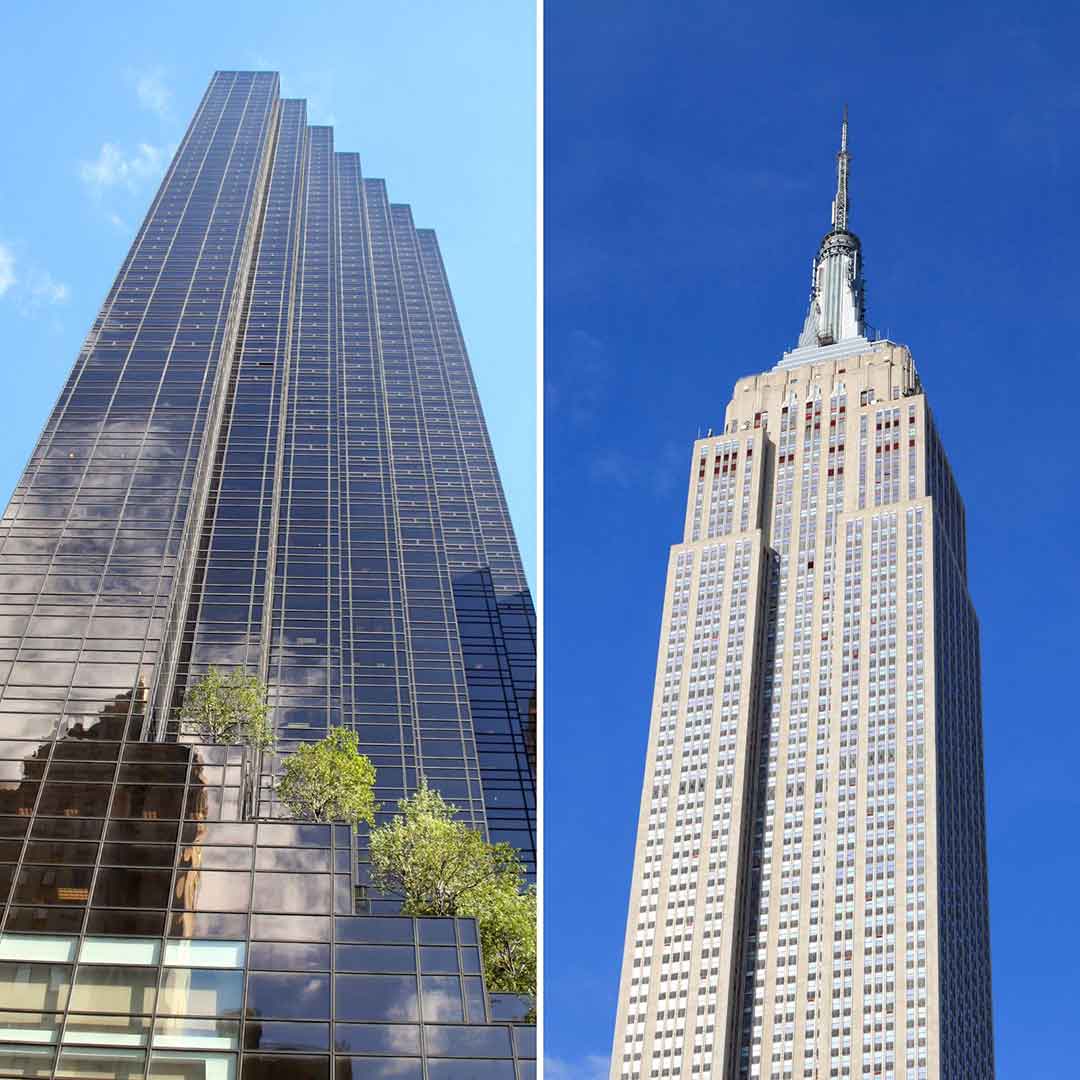
There are three general characteristics of commercial architecture. Firstly, commercial architecture focuses on developing spaces for commerce and trade purposes. The construction of the Empire State Building in New York City is an economic opportunity for the city and an architectural marvel. Secondly, commercial architecture serves a dual purpose of business and leisure. The Marina Bay Sands Mall in Singapore offers a resort complex with a casino, mall, hotel, and convention center. The multi-use resort is a one-stop experience for all your vacation needs. Thirdly, commercial architecture focuses on creating infrastructure that is practical and efficient. The Fulton Center in New York City uses its space efficiently by providing a major transportation hub connecting retail stores and subway lines. The Fulton Center masterfully amalgamates a major nexus of commerce and functionality.
13. Industrial architecture
Industrial architecture is a design style that offers productive and useful spaces for industrial operations. Industrial architecture rose to prominence as a response to the burgeoning demand for manufacturing and production spaces. Industrial architecture aims to create spaces that have open layouts to maximize utilization and to create space for equipment and operations. The Industrial Revolution created industrial architecture in the late 18th and early 19th centuries because of the rise in demand for manufacturing. For example, the Fagus Factory in Germany showcases industrial architecture through a clear façade and expansive glass outer look, marking a notable break from the previous period’s use of brick structures. Industrial architecture has historical importance because of its sociological and new technological advancements that the previous periods never had.
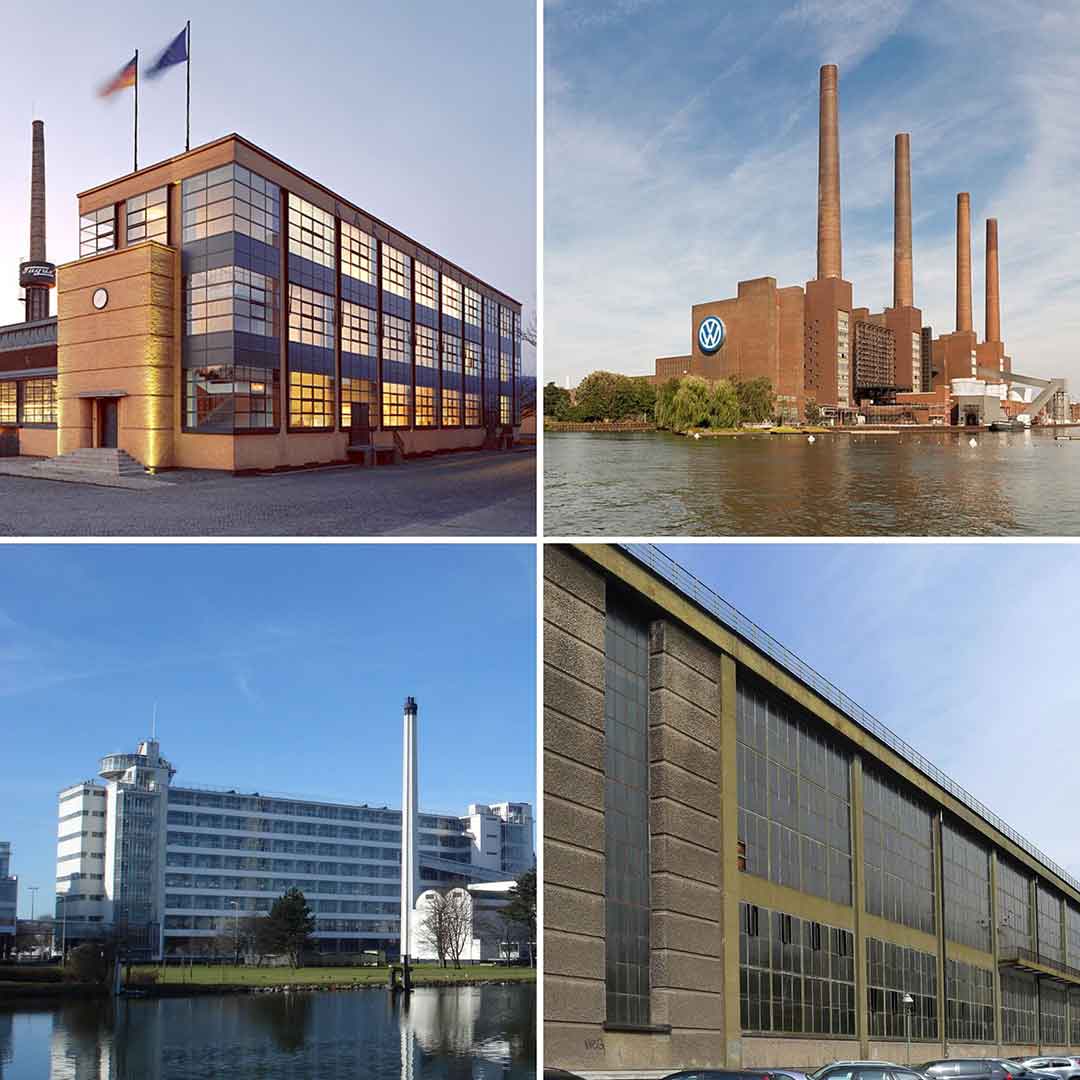
Three characteristics define industrial architecture. Firstly, the primary objective of industrial architecture is to focus on building spaces for industrial processes. For example, the Volkswagen Factory in Wolfsburg, Germany, is an archetype of a sustainable manufacturing facility intentionally built to capitalize on the functional space. Secondly, industrial architecture prioritizes natural light with unfinished and exposed elements. For example, the Van Nelle Factory in Rotterdam, Netherlands, showcases extensive large windows designed to optimize workflow and natural light, ensuring an efficient and worker-friendly environment. Thirdly, industrial architecture incorporates large open floorplans. For example, the AEG Turbine Factory in Berlin, designed by Peter Behrens, is a testament to the expansive open layouts common in industrial settings. The spacious interior and robust construction provide the necessary space to house large turbine assemblies while showcasing the aesthetic potential of industrial architecture.
14. Institutional architecture
Institutional architecture is an architectural style that aims to create structures for organizations with a clear and particular purpose. Institutional architecture is adaptable and creates functional and effective spaces for industries such as government offices, courthouses, schools, and hospitals. The 19th and 20th centuries witnessed the construction of various institutional buildings and projects. For example, the United States Capitol Building by William Thornton in Washington D.C. is an institutional architecture building that symbolizes governance. The Capitol Building symbolizes Democratic values and serves as a functional space for government workers. It exudes political reverence through its incorporation of neo-classical design elements. Institutional architecture is historically important because it reflects the values of religious, cultural, and political institutions worldwide.
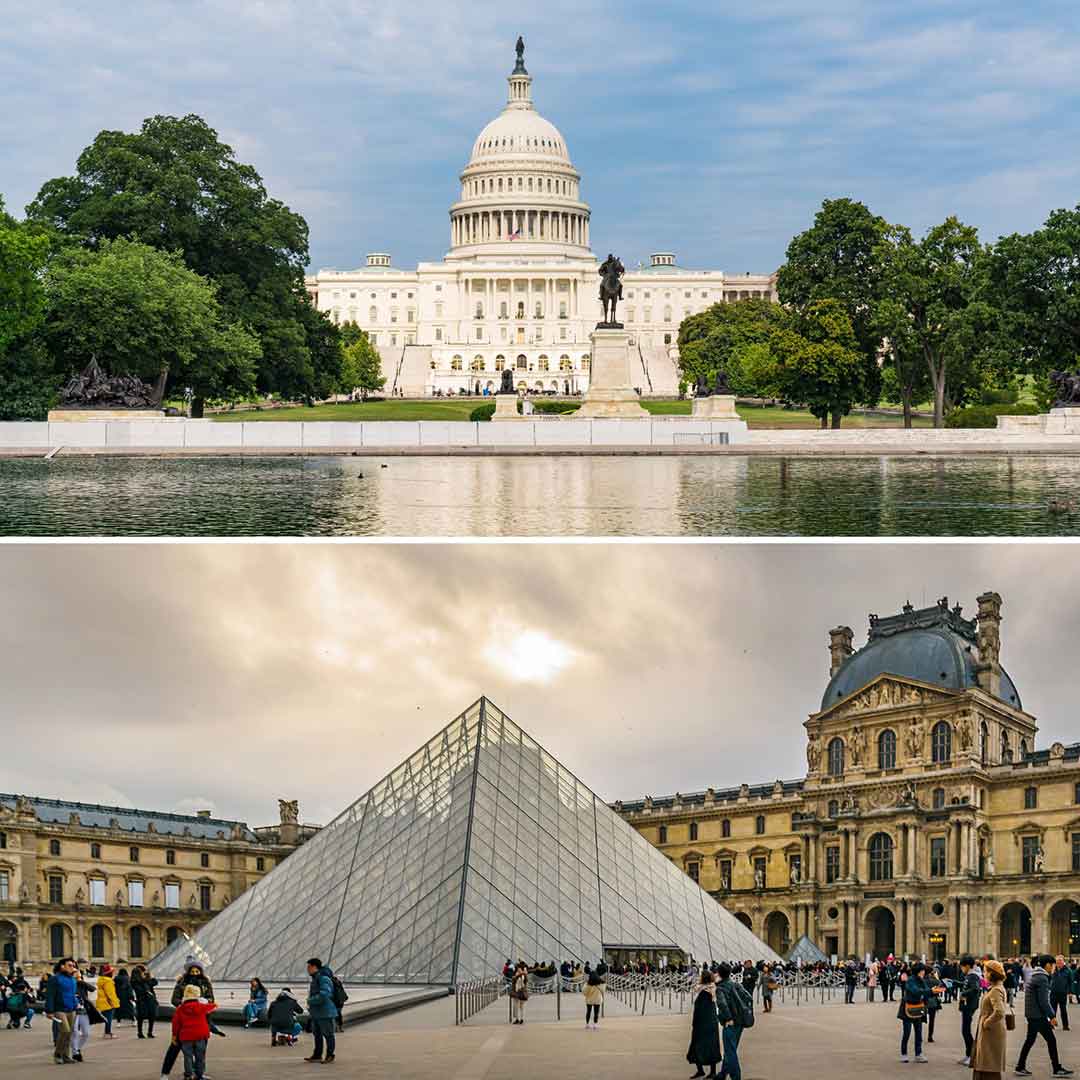
There are three distinctive characteristics of institutional architecture. Firstly, institutional architecture is adept at conceiving and building libraries. The Library of Trinity College in Dublin stands out as an architectural marvel. Secondly, institutional architecture showcases its prowess through university edifices and encompassing environments. The expansive campus of Harvard University in the United States, along with its array of academic libraries, encapsulates the essence of institutional architectural genius. Thirdly, institutional architecture works to build museums and celebrate human history and artistry. The Louvre Museum in Paris is a repository of a vast array of art and artifacts. It welcomes global visitors to immerse themselves in history and architectural splendor.
15. Landscape architecture
Landscape architecture is a discipline that focuses on creating and managing property based on outdoor spaces. Landscape architecture involves various environments such as landscapes, gardens, public plazas, and parks and incorporates plants, water, and natural landforms. Landscape architecture took off in the 19th century and continued to evolve as a profession into the 20th century. For example, Central Park by Frederick Law Olmsted, in New York City, is a paradigm of landscape architecture. Central Park was designed in the mid-19th century and has an extensive landscape of water, meadows, and woodlands. Central Park features crafted trails and uses landscape architecture to uplift the area. Landscape architecture is of great historical importance because of its role in creating and preserving environmental green spaces in urban developments. Preserving greenspace through landscape architecture creates an oasis between soaring skyscrapers and urban sprawl.

Landscape architecture has three main characteristics. Firstly, landscape architecture involves the creation of new green spaces. The Butchart Gardens by Jennie Butchart, located in British Columbia, Canada, has transformed from a limestone quarry to a gorgeous landscape with themed gardens such as its Japanese Garden and Sunken Garden. Secondly, landscape architecture features sustainable elements within its design. The sustainable design of the Gardens by the Bay in Singapore shows landscape architecture’s innovation in balancing aesthetics and ecological preservation. Thirdly, landscape architecture works to blend a variety of different environments. The Cheonggyecheon Stream Restoration Project in Seoul combines natural waterways and pedestrian pathways. The sprawling pedestrian features allow for functionality that invites people to partake in the public spaces.
16. Interior architecture
Interior architecture is an architectural discipline that focuses on the layout and design of interior spaces. Interior architecture meticulously orchestrates the design of a building’s interior elements and the integration of materials to create aesthetically pleasing rooms. Interior architecture became popular during the late 19th and early 20th centuries to create harmony between construction and aesthetic space. For example, the distinctive interior style of the Guggenheim Museum by Frank Lloyd Wright, in New York City demonstrates innovation of interior architecture. The museum has a renowned conventional layout and unique features, such as its spiral ramp design and intelligent integration of art styles. Interior architecture is historically important due to its ability to capture the cultural landscape and preserve past architectural elements.
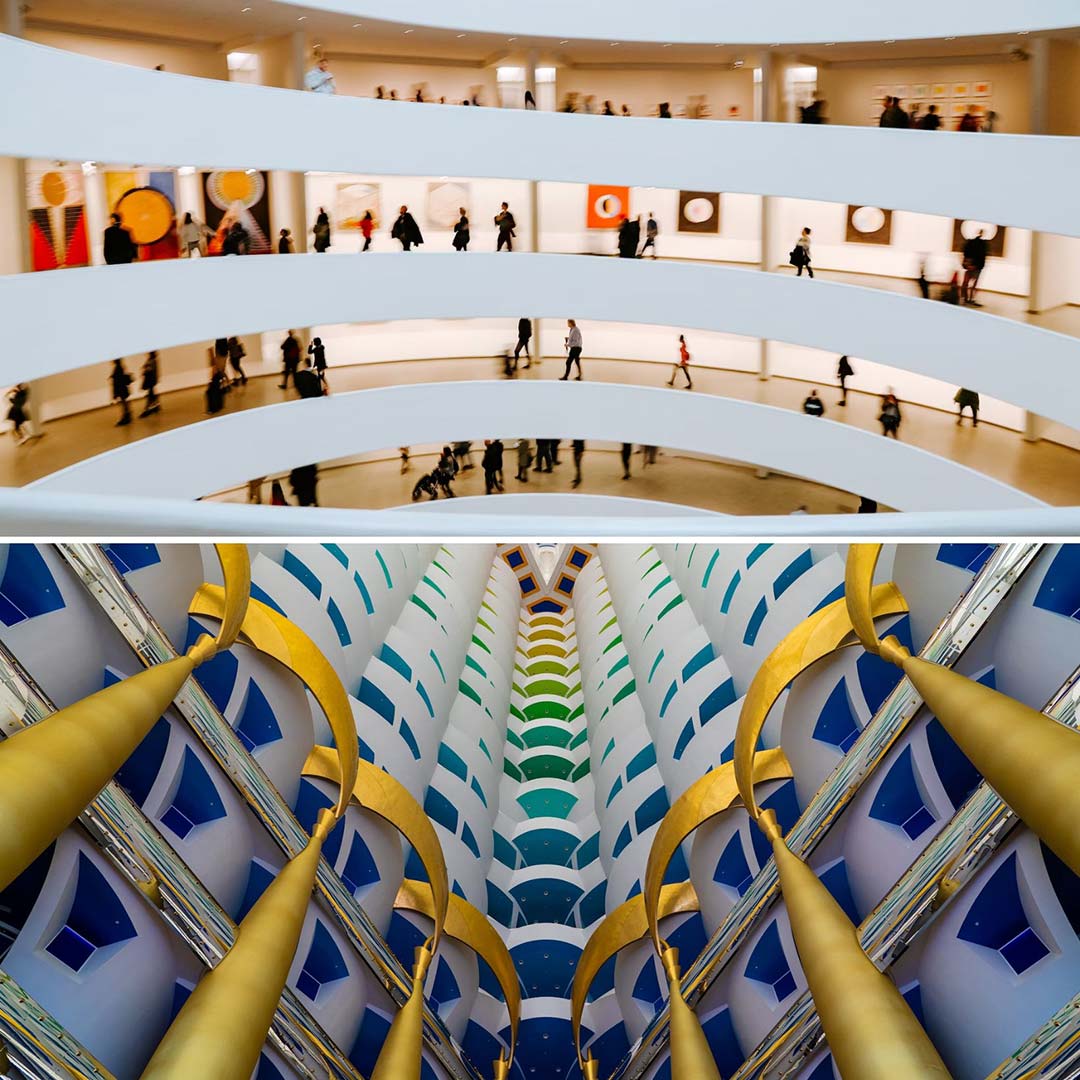
Interior architecture has three definitive characteristics. Firstly, interior architecture uses luxurious and extravagant detailing. The luxury hotel Burj Al Arab by Khuan Chew, located in Dubai, has an interior designated to luxury and opulence. The interior architecture of Burj Al Arab offers an intoxicating visual experience due to the multistorey structure’s vertical onslaught of rooms. Secondly, interior architectural design highlights versatility and depth to get the most out of a structure’s floor plan. The Glass House in Connecticut by Philip Johnson encapsulates the epitome of an open floor plan. The free flow of living space allows for flexibility and functionality to prosper. Thirdly, interior architecture melds the essence of the past alongside contemporary designs. The Hearst Castle in California features Roman influence throughout the interior pools, statuaries, and mosaics. The living quarters within Hearst Castle are an amalgamation of Gothic, Neo-Classical, and Spanish Colonial, adorning design elements young and old.
17. Sustainable architecture
Sustainable architecture prioritizes the creation of structures that harmonize with their environment and consume resources judiciously. This innovative design philosophy draws on cutting-edge technologies and smart design principles to ensure that buildings have a minimal harmful impact on both the natural world and local communities. The overarching aim is to foster long-lasting, responsible designs that contemplate every aspect of the product’s life cycle, from site choice and material selection to energy consumption and eventual decommissioning. Sustainable architecture makes intentional use of recycled, reclaimed, or rapidly renewable building materials in order to reduce a construction’s environmental footprint. Bamboo, which grows and matures in as few as three years, is a popular alternative to hardwood, as are other natural materials such as straw bales, hempcrete, and even sheep’s wool. Sustainable architects heavily source recycled industrial resources such as concrete, steel, plastic, and glass in order to reduce waste as well as energy costs of producing virgin material.

One of the most famous examples of sustainable architecture is Seattle’s Bullitt Center, which boasts net-zero energy consumption through a large rooftop solar array, total avoidance of toxic building materials, rainwater harvesting, ground-source heating, compost toilets, and natural daylighting. The necessity of such radical concepts is evident in the effort to combat anthropogenic climate change, and sustainable projects are often as much about proof of concept as they are about practicality.
18. Power architecture
Power architecture is a symbolic means for conveying wealth, power, permanence, and authority through construction. It is not a distinct school of architecture so much as it is an ethos of power projection. Examples of power architecture date back to antiquity, with salient examples including the Great Pyramids of Giza, the triumphal arches of Rome, and even the Gothic cathedrals of medieval Europe. However, the concept is very much germane to modern architectural goals, with monumental works like the Burj Khalifa symbolizing the economic might and technical prowess of the United Arab Emirates through its unprecedented height. Similarly, the aluminum cap of the Washington Monument was a display of the US’s ability to produce this then-expensive alloy.

There is no single style that encapsulates power architecture, but there are three unifying characteristics shared by most examples. First, power architecture relies on sheer scale to perpetuate the perception of unrivaled power of an authority (be it a state, corporation, or individual). Second, no expense is spared to convey wealth and endurance through ultra-premium materials like marble and gold. Finally, power architecture is inherently symbolic, making ample use of culturally significant motifs, shapes, and iconography.
19. Group housing architecture
Group housing architecture refers to planned residential buildings or complexes meant to accommodate multiple families with some degree of shared facilities. Group housing projects are necessarily diverse in order to serve the varying needs of different populations, but there are three general characteristics shared by most examples. First, group housing tends to feature common spaces like dining areas, recreational facilities, and gardens. These shared amenities foster a sense of community among residents while reducing the costs otherwise associated with individualized amenities. Second, planned community housing strives for the most efficient use of space in order to maximize the number of residents who can live there comfortably. The third major characteristic dovetails with the second in the careful balance between public and private space.
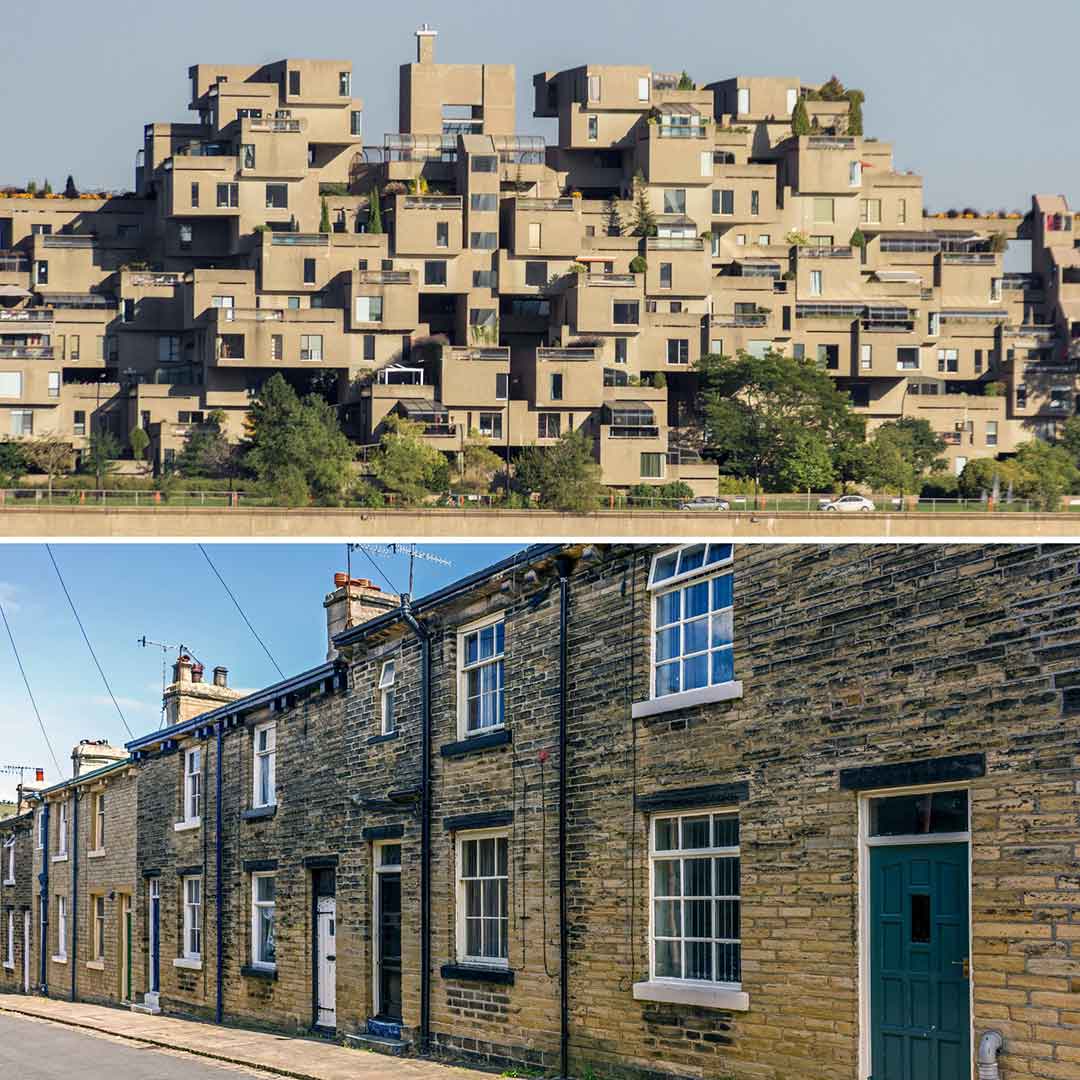
One of the most iconic examples of group housing is Montreal’s Habitat 67, which serves as a proof of concept for modular community planning. Its idiosyncratic staggered container design enabled neighbors to easily interact across each unit’s outdoor terrace while enjoying ample natural lighting, ventilation, and scenic views. Habitat 67 pioneered architecturally radical communal spaces in 1967, but the concept of group housing architecture dates back to the Industrial Revolution as a means to accommodate urban population booms. The Saltaire workers’ village of Yorkshire, England was a product of communal planning that sought to address the squalor of industrial slums. Sir Titus Salt designed his entire model village around a textile mill in a way that supported the productivity of the mill as well as the dignity and livelihoods of its workers.
20. Religious architecture
Religious architecture broadly defines constructions that reflect and serve the spiritual beliefs of those who construct them. Examples of religious architecture are ubiquitous throughout world history, encompassing churches, mosques, synagogues, temples, and shrines back to antiquity. These sites vary widely in their stylistic features but nevertheless share common goals of facilitating religious rituals, inspiring devotion through layout and ornamentation, and asserting the cultural prominence of the religion. One of the most famous examples of religious architecture is the Hagia Sophia in Istanbul. It was built by the 6th-century Byzantine Emperor Justinian I as an Eastern Orthodox cathedral but later converted to a mosque following the Ottoman conquest of Constantinople. The Hagia Sophia bears a striking mix of Christian and Islamic art, iconography, and architectural features, which together reflect the layered cultural mosaic of Turkish history.
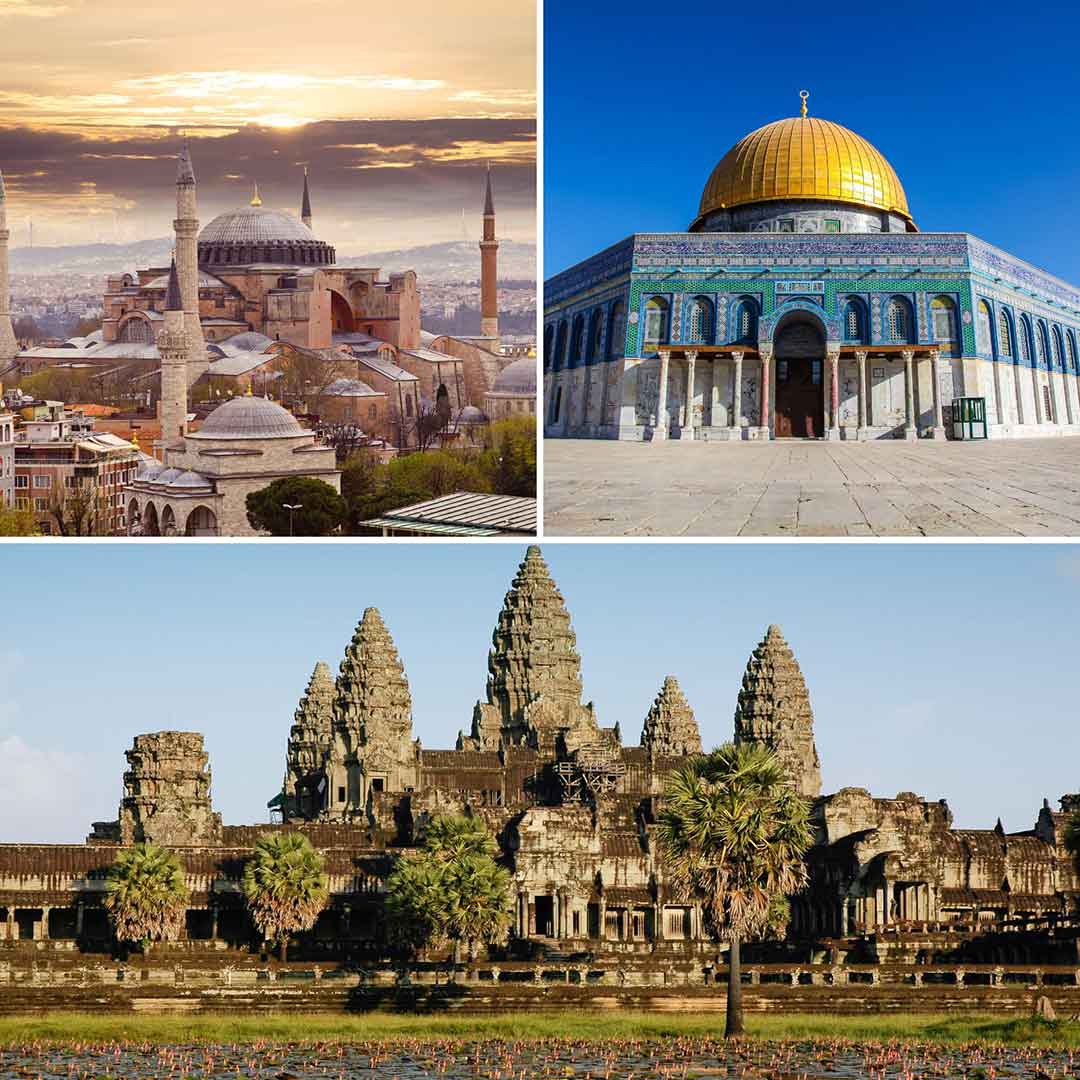
Religious architecture is a cornerstone of human civilization, serving not only as places of worship but as centers of cultural, intellectual, and philanthropic activity. Moreover, religious constructions provide some of the earliest evidence of communal cooperation. For example, one of the oldest extant buildings in the world is Göbekli Tepe in Turkey, which archaeologists date back as early as 9500 BCE. The exact nature of the site is a matter of debate, but evidence suggests that Göbekli Tepe served as a gathering place for ritualistic activity.
21. Governmental architecture
Governmental architecture refers to structures that symbolize or facilitate the governance of a given jurisdiction. These buildings typically symbolize the authority, stability, and values of the state or institution they serve. Common examples of governmental structures include courthouses, town halls, embassies, palaces, as well as executive and legislative buildings. These buildings usually occupy prominent locations central to the town or city they serve in order to facilitate easy access by the public. However, governmental architects tend to balance access with security in order to ensure continuity of service even amidst societal instability.
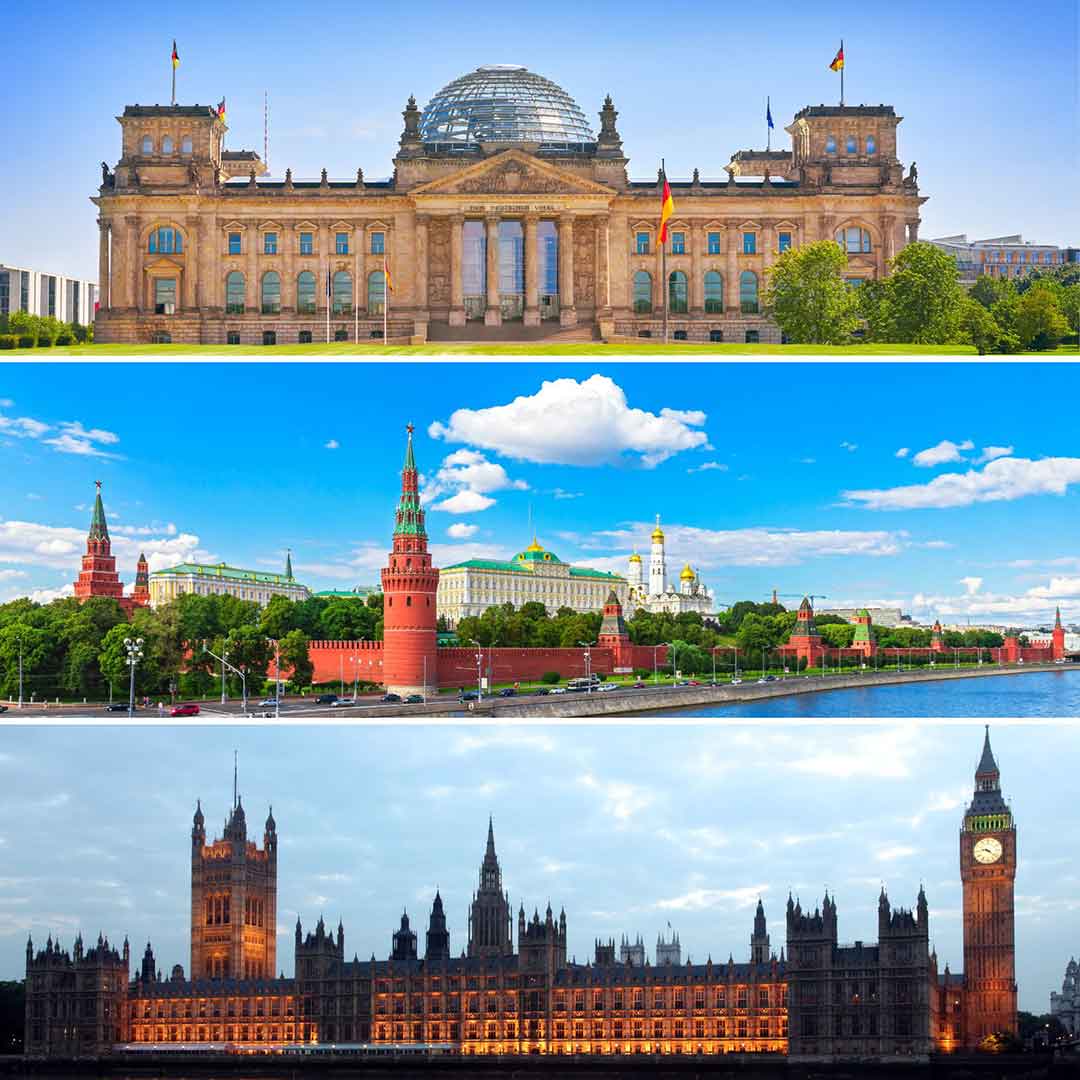
The Kremlin of Moscow is emblematic of the dynamics that shape governmental architecture. Its initial construction as a wooden fortress in the 12th century has been revised and improved upon by successive Russian leaders. The most notable of these renovations occurred during the reign of Ivan the Great in the 15th century. He not only fortified the structure with red brick but enlisted prominent Italian architects to reshape the Kremlin, blending the latest Renaissance fashions with traditional Russian stylings in an effort to elevate both. It was under Ivan that the Cathedral of the Assumption was constructed in a move to consolidate religious, cultural, and political power. Later additions further bolstered the prestige of the Kremlin (and thus, the state), such as the Grand Kremlin Palace completed by Tsar Nicholas I in 1849. Today, the Kremlin serves as the seat of power for the Russian government as well as a locus for Russian history and culture.
What are the aesthetic elements in architecture?
Aesthetic elements in architecture are concepts that influence the design of a structure. Architects consider these concepts to dictate the function, visual impact, and experiences humans have within, around, or while viewing a building. The list below summarizes the main aesthetic elements in architecture.
- Form and shape: Form and shape define a building’s composition. Form refers to the three-dimensional organization, function, and appearance of a structure while shape is the two-dimensional, geometric elements that affect our perception of a structure.
- Line: Lines in architecture are edges and boundaries created by interconnecting visual paths. They define shape and form as well as influence the aesthetic impression through visual direction created by different types of lines.
- Color: Color in architecture is an aesthetic element that impacts the visual mood, depth, movement, and texture of a structure. Warm, cool, and neutral colors influence a building’s design, stimulating different experiences depending on the palette.
- Texture: The aesthetic element of texture defines the visual and physical surface qualities of a structure. These qualities impact the sensory experience of a structure, leading architects to be selective about the texture of materials used.
- Light: Light as an aesthetic element is used to define a building’s form and features. Light additionally influences spatial perception, mood, and functionality, achieving different results depending on the type of light used.
- Scale: Scale in architecture compares or relates a structure’s size to another object. Architects use scale to consider the human experience within or around a structure as well as the prominence or intimacy of a design.
- Space: Space in architecture is a three-dimensional physical area within and around a structure. Architectural borders define space while the spatial layout of a structure influences how it is organized, functions, and is aesthetically experienced.
- Movement: The aesthetic element of movement refers to the flow of a structure’s design. Movement affects how humans move through a space, as well as how other elements influence our perception of flow in a given area.
- Symbolism: Symbolism refers to the meaning a structure conveys. Symbolism is cultural, religious, or historical and imparts an artistic message the architect desires to share with viewers or inhabitants of a structure.
- Context: Context in architecture encompasses the physical, environmental, social, historical, and aesthetic factors that influence a building’s design and development. Architects consider the context of a structure to better determine its intent and visual impact.
1. Form and shape in architecture
Form and shape in architecture refer to the aesthetic elements that define the composition of a building. Form encompasses the overall three-dimensional configuration of a building, including its size and the physical exterior and interior features that define its design. The three-dimensional spatial organization, functionality, and aesthetic impression a building evokes are all examples of form. Meanwhile, shape in architecture is two-dimensional, encompassing geometric elements created by boundaries and edges that distinguish form. A building’s shapes affect its aesthetic by influencing our perception of the visual environment and how the form of architectural elements appear balanced or unbalanced. For example, the Colosseum in Rome, Italy presents a two-dimensional elliptical or oval shape from the sky that evokes a cohesive, symmetrical design.
All types of architecture reflect form and shape as they are fundamental elements of design. Architects use these elements to determine the composition of a structure and the distinct impression it leaves. This choice is dependent on any number of factors, such as cultural influences or artistic vision. Consequently, architects have different approaches and philosophies regarding shape and form. For example, the quote by American architect Louis Sullivan, “Form follows function,” states that the building’s form (and by extension shape) should prioritize its intended purpose. Sullivan himself designed structures like the Wainwright Building which emphasizes square shapes and simple forms that are practical and conventional. However, architectural types like deconstructivist architecture challenge this idea. Deconstructivism distorts form and shapes through jutting angels and irregular figures, prioritizing aesthetics over functionality by causing humans to question the three- and two-dimensional composition of a structure.
2. Line in architecture
Lines in architecture are another core element referring to paths that connect two or more points to create edges, boundaries, and patterns. Lines are fundamental to architectural design as they evoke shape and form by defining the visual paths and limits of a building’s composition. For instance, four different types of lines affect the visual impression of architectural designs. Firstly, horizontal lines are explicit or implied paths running parallel to the horizon. These lines prompt stability, balance, and space by extending the perception of length and guiding the human eye along a level path. Secondly, vertical lines in architecture run perpendicular to the horizontal. These lines promote the height, elevation, and grandeur of a structure. Thirdly, diagonal lines are implicit or explicit paths that draw the eye at a slanted angle. Diagonal lines create a sense of movement by directing our gaze away from the horizon at an angle, generating interest and skewing away from the symmetry of vertical and horizontal lines. Finally, curved lines are arched, irregular visual paths. Such lines are more organic, emphasizing asymmetry and flow. Spanish architect Antoni Gaudí was partial to curved lines, famously stating that “The straight line belongs to men, the curved one to God.” Gaudí’s words mean that straight horizontal, diagonal, and vertical lines are key to architecture, but curved lines are visually stimulating and more in line with nature.
The usage of lines is visible in all types of architecture, but some styles emphasize lines more acutely than others. For example, classical architecture stresses straight vertical and horizontal lines through features like columns to impose a sense of orderliness and grandeur. Meanwhile, deconstructivist structure challenges conventional applications of line through fragmentation and distortion whereas modern architecture leans on clean, stark lines that are largely inorganic. Parametric architecture additionally reflects the architectural element of the line by imposing complex curves and diagonals that draw the eye. Conversely, the linework of postmodern structures is less complex but similarly experimental—building off the starkness of modern buildings to be more intricate and whimsical.
3. Color in architecture
Color in architecture is a foundational aesthetic element that determines the visual impression of a structure’s exterior or interior. Color affects a design’s mood as well as the appearance of depth, movement, and texture. For example, different types of colors prompt different types of impressions, similar to shapes or lines. The key distinction is that color pertains to the hues and visual attributes. Warm colors like reds, oranges, and yellows create comforting or energizing moods, provide an enclosed yet comfortable sense of depth and movement, and visually stimulating textures. Cool colors like blues and greens foster serene moods, deepening the illusion of depth and airiness of space so it appears larger and textures appear smoother. Meanwhile, neutral colors such as whites, grays, and beiges stimulate a relaxing and centered aura, reducing the movement or stimulation of elements and prompting either an open or enclosed space depending on the colors used.
The choice and use of color vary among architects and the types of structures they design. For instance, Antoni Gaudí remarked that “Color in certain places has the great value of making the outlines and structural planes seem more energetic.” The quote emphasizes the flexibility of color in architectural design as Gaudí utilized a broad and vivacious palette in his work. One type of architecture that emphasizes color is postmodern designs and religious structures. Postmodern architecture capitalizes on color, utilizing it to create contrast and visual distinction to draw the human eye. Meanwhile, religious architecture such as Gaudí’s own Sagrada Familia leverages colors as symbolism with specific palettes representing fundamental elements of a region, culture, or belief. The Sagrada Familia Cathedral in Barcelona, Spain emphasizes color through stained glass, mosaics, and decals to illustrate religious themes while creating a whimsical mood that makes it distinct from other types of Gothic and Art Nouveau architecture.
4. Texture in Architecture
Texture in architecture is an aesthetic element concerning the visual and physical surface qualities of a structure. Architectural texture impacts a building’s sensory experience, prompting specific moods, ideas, or visualizations of how a structure feels. Visual texture governs a human’s perception of materials, light, or color. For instance, corten steel rusts over time, providing a visual texture of roughness, age, and durability. Meanwhile, physical texture refers to the tactile qualities that humans touch. Physical texture is an important aesthetic element as it impacts how humans interact with and feel about a structure. For example, the extensive use of polished hardwood floors in an interior space is smooth to walk across, providing a glossy tactile dimension and a feeling of refinement.
Architects select materials partially according to their texture in order to provide specific sensory experiences. A quote by Mies van der Roh remarks on materials, stating, “Each material has its specific characteristics which we must understand if we want to use it.” This means that every material utilized in a structure provides unique qualities that architects must understand to elevate their design. The same applies to the quality of textures, which impact the function, aesthetic, and physical feel of a structure. Therefore, different types of buildings employ different textures to achieve cohesive tactile and visual elements. One type of architecture that emphasizes texture both visually and physically is brutalism. Brutalist structures tend to use raw, exposed concrete, prompting a rough and unrefined visual and physical texture that inspires starkness and austerity.
5. Light in architecture
Light in architecture refers to the usage of natural or artificial light sources to define or enhance a building’s composition. Light is an important aesthetic element of architecture as it affects our perception of a structure. This in turn affects mood, functionality, and the emphasis of certain architectural elements. For example, natural or artificial lighting affects the appearance of edges and contours, enhancing or obscuring shape, form, lines, and shadows to accentuate the features so they appear more vivid or soft. Natural light generated by the sun tends to prompt an organic, warm mood whereas artificial sources of light broadly affect mood depending on the color of the lighting. A quote by Louis Kahn remarks, “A room is not a room without natural light,” suggesting that natural light is indispensable to design. That said, artificial sources enable the functionality of a space, providing critical illumination so that structures are navigable whereas natural light is dependent on the time of day.
Light is pivotal to architecture as it influences various visual factors that define our experience in a structure, be it natural or artificial. Different types of architectural design such as baroque, minimalist, and landscape architecture capitalize on light in order to emphasize design elements. Baroque design uses the formation of architectural elements like lines and concaves to employ contrast, exaggerating light and shadows in order to evoke grandeur. Conversely, minimalist structures emphasize natural light through stark, simple design to create an open, airy atmosphere that doesn’t distort light sources. Meanwhile, landscape architecture employs natural light to create a cohesive, organic environment that integrates with nature while utilizing artificial illumination for functionality.
6. Scale in architecture
Scale in architecture is the relation of a structure’s size to its surroundings. Scale either compares a structure as a whole or its individual architectural features to another object. There are four different types of scaling in architecture—human, monumental, intimate, and hierarchical scale. Human scale refers to the ratio between a structure and the average human. Human scale is important as it considers how an individual physically navigates or views a space with proper scaling achieving comfort and accessibility. Meanwhile, monumental scale refers to the comparison of size between a prominent building and its surroundings. Monumental scale emphasizes grandeur and tends to be employed with culturally or socially significant buildings like skyscrapers, government buildings, or landmarks. On the other hand, intimate scale generally accounts for interior spaces or small structures. The purpose of intimate scaling is to facilitate comfort and connection between a person and a structure. Finally, hierarchical scale refers to design choices that make certain features or buildings appear larger and more prominent than other objects, though not necessarily to the same degree as monumental scale. For example, the central fountain of a courtyard is generally larger than other elements, indicating it’s the main attraction.
Different types of architecture employ scale as an aesthetic element to influence the visual impact of a structure. Scale is consequently fundamental to effective architectural design. American architect and engineer Julia Morgan once remarked, “Architecture is a visual art, and the buildings speak for themselves.” Morgan’s quote emphasizes that architecture is a visual medium which means that aesthetic qualities like scale speak to a structure’s intended impact. For example, gothic architecture emphasizes monumental scale and soaring features that speak of religious fervor. Meanwhile, government architecture and religious architecture use a monumental or hierarchical scale to convey grandeur and significance in an urban space. Conversely, interior architecture utilizes scale to create a functional and oftentimes intimate-feeling space.
7. Space in architecture
Space in architecture refers to the physical expanse within and around a structure. Space in an architectural context is three-dimensional, similar to form. Architects use space to dictate the organization, perception, lighting, and functionality of an area within or around a building. For example, the spatial arrangement of physical elements, like walls, windows, and archways, influences the configuration of interior space and how humans function, move, or conduct activities indoors. Space additionally separates the interior and exterior portions of a structure, helping to define experiences according to the functionality and visual characteristics of a building’s form. Consequently, architects consider space and its purpose as both a functional and aesthetic element of architecture. Louis Khan exemplified this in his quote, “Architecture is the thoughtful making of space.”
The mindful usage of space is evident across different types of architecture. For instance, religious architecture like cathedrals or mosques uses space to enforce a spiritual aesthetic as well as a practical function. The expansive, open interior space enclosed by a cathedral or mosque’s high walls and ceilings exemplifies intentionally exaggerated spatial organization, allowing a structure to accommodate many people while emphasizing religious fervor. Conversely, space in residential architecture tends to value function over aesthetics. Space within effective home design considers the layout of rooms in order to accommodate human needs and how an individual might move or interact within a given area.
8. Movement in architecture
Movement in architecture is an aesthetic element concerning the physical, visual, and psychological flow or motion of a structure’s design. Physical flow in an architectural context governs how humans move through a structure according to the configuration of spaces, pathways, and circulation. Physical movement ensures that people are able to safely and efficiently circulate across a structure through the use of corridors, stairs, ramps, elevators, and similar. Meanwhile, visual movement concerns the design of aesthetic elements that guide the human eye and create a sense of rhythm. The aforementioned elements of form, shape, line, space, light, color, and scale all influence visual movement by drawing attention to specific features, and affecting our perception of a structure. Psychological movement capitalizes on visual movements by influencing a human’s perception of rhythm and flow to achieve certain moods or functions. For example, neutral tones, natural lighting, and curved walls in a yoga studio catch the eye, stimulating a fluid rhythm and energetic mood that prompts tranquility.
Architects consider movement as it affects the experience and function of a given space. Therefore, different types of architecture use movement to achieve different goals. Forms of industrial architecture emphasize physical movement, employing an efficient layout of machinery and pathways to optimize production and safe motions at work. Meanwhile, residential, landscape, group housing, and commercial architecture consider the physical, visual, and psychological movements of architecture to ensure that pathways and layouts are both accessible and subconsciously direct humans to different spaces through aesthetic elements. For example, malls and shopping centers employ movement to direct shoppers to various areas so they’re able to conduct all their purchases under one roof, preview sales, and window shop.
9. Symbolism in architecture
Symbolism in architecture is an aesthetic element that conveys cultural, religious, or historical meaning. The symbolic nature of architecture depends on the idea or message the architect is trying to express. Furthermore, certain structural elements historically correspond to specific symbolism. For example, the usage of domes in historical religious structures like the Hagia Sophia in Istanbul, Turkey relates to heaven and the expansiveness or transcendence of divine powers in Abrahamic religions. Ancient architects Isidore of Miletus and Anthemius of Tralles chose the dome to evoke a religious message as well as fulfill a functional purpose as domes support large, open spaces without columns. Additionally, symbolism is fundamental to many architects’ processes because, as artists, they desire to convey a message to an audience. For instance, Polish-American architect, Daniel Libeskind, remarked, “To provide meaningful architecture is not to parody history, but to articulate it.” This quote means that structures that use historical symbology should do so mindfully and encourage deeper interaction between the structure and humans.
Symbolism exists among different types of architecture, but not all structures or architects choose to use the element to convey a message. Types of architecture that generally emphasize symbolism include religious, governmental, postmodern, and deconstructivist structures. Religious architecture strives to include aesthetic elements with symbolic intent, choosing motifs and features that convey the faith. Meanwhile, government architecture often employs symbology through columns, grand staircases, and general monumental scale to convey authority. Meanwhile, postmodern architecture employs symbolism through vibrant colors, irregular shapes, or otherwise unconventional structures to serve as cultural or societal commentary. Deconstructivism does so similarly, selecting jagged and seemingly practical aesthetic choices as symbols that challenge norms and provoke thought about architecture.
10. Context in architecture
Context in architecture refers to the components, conditions, or circumstances that influence the development of a structure. Context includes physical, environmental, social, historical, or aesthetical factors that dictate how or why a building is built. Architects consider practical contexts, like the physical location, materials, and local infrastructure, as they design a building. Architects additionally evaluate a more abstract context such as the architectural heritage or visual harmony of a structure in its location and how these factors affect the final design. Context is consequently a major aesthetic element that governs many areas of the design process. For instance, a quote by British architect Norman Foster states, “As an architect, you design for the present, with an awareness of the past for a future which is essentially unknown.” One interpretation of Foster’s words is that architects must consider the context of both the present and future, making interpretations of the latter according to the former.
Architectural context varies from structure to structure due to the numerous factors that influence a design. Two prominent forms of architecture that emphasize context are vernacular and sustainable architecture. Forms of vernacular architecture emphasize context because structures are built according to the climate, geography, materials, and architectural heritage present in an area, reflecting a broad cultural context that dictates the building’s final design. Meanwhile, sustainable architecture highlights context because it considers both present-day and future environmental and ecological factors in order to dictate design and reduce harm to the building’s surroundings.
Who are the most important architects in history?
Below is a list of the most important architects in history.
- Frank Gehry: Frank Gehry (born February 28, 1929) is a Canadian-American architect who designed notable buildings like the Walt Disney Concert Hall and the Bilbao, Spain branch of the Guggenheim Museum. Gehry is one of the most important architects in history because his designs evoke innovative, playful, and diverse aesthetic elements that defy conventional architectural vision. Gehry doesn’t align with any specific movement, but he nonetheless remains influential in postmodern design due to the experimental forms and shapes expressed in his work.
- Frank Lloyd Wright: Frank Lloyd Wright (June 8, 1867 to April 9, 1959) was an American architect whose notable work includes the Solomon R. Guggenheim Museum in New York City and the Fallingwater house in Pennsylvania, United States. Wright was significant because he led the Prairie School movement, which featured distinct roof designs and stark, horizontal lines. Wright was additionally fundamental to American architecture, helping to distinguish it from other global styles and influence future generations of American architects.
- Ludwig Mies Van der Rohe: Ludwig Mies Van der Rohe (March 27, 1886 to August 17, 1969), otherwise commonly known as Mies, was a German-American architect who designed the Seagram Building and the Barcelona Pavilion. Mies is regarded as one of the most important architects in history because he was the primary figurehead of the international and modernist styles. He emphasized minimalist designs and the grandeur of steel and glass as aesthetic elements that influenced 20th-century architecture.
- Dame Zaha Hadid: Zaha Mohammad Hadid (October 31, 1950 to March 31, 2016) was an Iraqi-British architect who designed notable structures like the London Aquatics Centre and Guangzhou Opera House. Hadid is listed among the most significant architects in history because of her contributions to parametric and deconstructive styles, employing complex curves and shapes to create distinctive, futuristic designs. Hadid was additionally the first woman to win the Pritzker Prize, making her one of the most distinguished female architects of her generation.
- Antoni Gaudí: Antoni Gaudí (June 25, 1852 to June 10, 1926) was a Catalan architect and designer of noteworthy structures like the La Sagrada Família. Gaudí is one of the most distinguished architects in history due to his unique style and process. The Catalan architect experimented with different types of architecture, including neo-Gothic and organic forms, to develop a personal style that emphasized grandeur and naturalism. Gaudí additionally closely considered every aspect of his design, employing unconventional architectural elements and materials to create unique structures.
What are the most important architectural examples in history?
Below is a list of the most important architectural examples in history.
- Taj Mahal: The Taj Mahal is a 17th-century mausoleum designed by Ustad Ahmad Lahori and located in Agra, Uttar Pradesh, India. The Taj Mahal is one of the most historically notable examples of architectural design because it exemplifies Mughal architecture and engineering, highlighting the ornate and symmetrical Indian-Persian aesthetic elements associated with the Mughal time period. Additionally, the Taj Mahal’s symbolism is significant because it was commissioned by Emperor Shah Jahan for his late wife Mumtaz Mahal, illustrating how architecture can communicate abstract concepts like love and dedication.
- Hagia Sophia: The Hagia Sophia is an example of Byzantine architecture that was originally constructed in 537 CE. Anthemius of Tralles and Isidore of Miletus were the principal architects of the Hagia Sophia during the reign of Emperor Justinian I. The structure initially served as a Christian church and later an Islamic mosque in 1453 and again in 2020 after it was utilized as a museum. The Hagia Sophia’s changing usage is historically noteworthy as it represents the religious and cultural significance of the structure. Additionally, the Hagia Sophia is architecturally impressive due to its pioneering pendentive dome and interior design, making it one of the most prominent religious structures in the world.
- Eiffel Tower: The Eiffel Tower is an iron lattice structure located in Paris, France designed by Gustave Eiffel. The Eiffel Tower doesn’t align with any particular type or style of architecture, but it does exemplify 19th-century iron lattice construction. Historical significance derives from the Tower’s innovative design, which was a hallmark of the technological leaps made during the Second Industrial Revolution. The Eiffel Tower is additionally important to architectural history because it illustrated the possibilities of iron as a malleable and artistic building material.
- Chrysler Building: The Chrysler Building is a skyscraper designed by William Van Alen and located in New York City, United States. The building serves as an example of American Art Deco architecture, exhibiting stark geometric shapes and symbolism. The Chrysler Building is one of the most historically important examples of architecture because it’s a hallmark of the skyscraper engineering era of the 1920s. It illustrates the significant strides made to develop structures on a monumental scale while retaining unique aesthetic elements attributed to the 1920s Art Deco movement. The Chrysler Building now serves as one of the most iconic buildings in the New York cityscape.
- Notre Dame Cathedral: The Notre Dame Cathedral is a Gothic structure located in Paris, France. Its construction originally began in 1163 and was completed in 1345, though it has been renovated extensively throughout the centuries. No single architect is attributed to the cathedral’s design, but it nonetheless remains historically significant because it exemplifies Gothic architecture. The stained glass windows, pointed arches, flying buttresses and ribbed vaults of the Notre Dame cathedral are hallmarks of classic Gothic architecture, illustrating the innovation of initial medieval French engineering, dedicated renovation, and religious symbology and context that influenced the cathedral’s most notable features.
What are the quotes about architecture?
Below is a list of famous quotes about architecture and their meanings.
“Architecture should speak of its time and place but yearn for timelessness.” – Frank Gehry
- The first quote above by famed architect Frank Gehry emphasizes the importance of a structure’s context in addition to its permanence. Gehry’s quote suggests that the intent of architecture is multi-faceted, reflecting the period and location it was built, as well as how or why, but the architect must additionally strive to transcend time so that a structure remains important in the years to come.
“God is in the details.” – Ludwig Mies van der Rohe
- The second quote by Ludwig Mies van der Rohe is famous for emphasizing the architect’s personal approach to design. It indicates that effective architecture considers every aspect of a structure, particularly minute details that enhance a structure’s visual impact and function. The quote additionally highlights Mies van der Rohe’s minimalist philosophy and use of simplified forms to emphasize unambiguous details.
“There are no straight lines or sharp corners in nature. Therefore, buildings must have no straight lines or sharp corners.” – Antonio Gaudí
- The third quote signifies that architecture should reflect natural elements, according to Gaudí. The Catalan architect preferred organic forms and shapes, meshing them with neo-Gothic influences to create a unique aesthetic that breaks away from conventional design. Gaudí’s Sagrada Família and Park Güell in Barcelona both exemplify the architect’s words through their organic albeit whimsical forms.
“As an architect, you design for the present, with an awareness of the past, for a future which is essentially unknown.” – Norman Foster
- The fourth quote above means that architects must consider the past, present, and future context of a structure. Foster is notable in British modernist architecture and consequently strives to evaluate the existing relevance of a project, in addition to any historical significance and future value. The quote’s meaning is similar to the first quote by Frank Gehry which encourages architects to transcend time.
“When I’m working on a problem, I never think about beauty. But when I’ve finished, if the solution is not beautiful I know it’s wrong.” – Buckminster Fuller
- The fifth and final quote derives from the American architect Buckminster Fuller, designer of the Montreal Biosphere’s geodesic dome. The quote signifies that aesthetics shouldn’t be the main focus of the architectural process as the structure’s beauty is inevitable if the architect’s design and problem-solving skills are efficient. However, the process or applied solutions are wrong if the end result isn’t aesthetically pleasing.
What are the best books about architecture?
Below is a list of the best books about architecture.
- Architecture: Form, Space, and Order by Francis D. K. Ching: Architecture: Form, Space, and Order was originally published in 1979 and consists of 447 pages. The fourth edition of the book is an extensive overview of architectural design. It provides an introduction to concepts like space, form, light, organization, hierarchy, and circulation as fundamental components of design. Ching additionally includes informative illustrations to accompany the concepts, providing references for readers who choose to sketch as they learn. The introductory nature and illustrations are supported by simple language, making it one of the best books about architecture for both students and professionals.
- The Image of the City by Kevin Lynch: The Image of the City is a 1960 book consisting of 194 pages and concerning urban planning and architecture. Lynch’s book addresses how humans interact with a city and how these interactions evolve. Lynch provides case studies to support his ideas and suggests that five concepts of paths, edges, districts, nodes, and landmarks shape how humans interact and identify with an urban environment. The book intends to advise how architects can utilize these concepts to enhance their artistic vision, making it one of the best publications on architecture for urban-focused designers.
- The Eyes of the Skin: Architecture and the Senses by Juhani Pallasmaa: The Eyes of the Skin was originally published in 1996 and consists of 128 pages. The book explores how the human senses stand to enhance buildings through a philosophical retrospective of architecture. The main point of Pallasmaa’s book is to dissuade the idea that architecture is solely a visual medium and that aesthetic qualities like texture or space enable a deeper sensory experience and psychological connection between a structure and a human.
- Atmospheres: Architectural Environments. Surrounding Objects by Peter Zumthor: The 2006 book Atmospheres by Swiss architect Zumthor has a page count of 75 and consists of a series of short essays with illustrations. We list it among the best books about architecture because it provides insight into Zumthor’s mental process as a notable architect. Zumthor explores how nonphysical characteristics of space influence the impact of a structure, emphasizing that architecture is a form of art and art is meant to provoke unique experiences in humans.
What are the best podcasts about architecture?
Below is a list of the best podcasts about architecture.
- 99% Invisible: 99% Invisible is a podcast hosted by Roman Mas with an average runtime of 30 to 35 minutes, though some episodes run as long as an hour. 99% Invisible distinguishes itself among podcasts because its content focuses on the overlooked or unknown aspects of architecture, such as intangible or minuscule elements that create an efficient design. Host Roman Mars consequently provides insight into the complex and unnoticed elements that professional architects recognize whereas hobbyists and casual listeners cannot.
- About Buildings and Cities: About Buildings and Cities is an architecture podcast that focuses on individual structures, urban settings, and historical design. The podcast is hosted by Luke Jones and George Gingell with episodes running approximately an hour long. About Buildings and Cities is one of the best architecture podcasts because it offers a broad scope, touching upon topics like history and urban realities, and their relation to city infrastructure and design. The podcast is consequently suitable for professional architects, hobbyists, and casual listeners interested in learning more about architecture from a holistic standpoint.
- Archispeak: Archispeak is a podcast hosted by Evan Troxel and Cormac Phalen who are professional architects. The episode length averages 45 minutes to an hour and discusses the realities of working in architecture. The podcast is consequently targeted at fellow professionals. However, the subject matter is suitable for more casual listeners as it explores the ongoings and challenges of architecture and design careers as well—content that is deepened by the hosts’ and guests’ personal insights
- DnA: Design and Architecture: DnA was a podcast hosted by Frances Anderton for the KCRW Californian radio station. Episodes generally run for 25 minutes. DnA ended in 2020, but it remains one of the best podcasts about architecture because it provides targeted insight into California design. The episodes examine topics such as urban planning through a Californian lens. Host Frances Anderton additionally offered professional insight based on her own extensive architectural career.
What to know about building architectural design?
The list below details important facts to know about building architectural design.
- Architecture design consists of seven phases: Architects follow a process of seven phases composed of pre-design; schematic design; design development; construction documents; building permits; bidding and negotiation; and construction. Each phase demonstrates specific measures and procedures architects or architectural firms must follow to complete a project.
- Architects use various tools: The tools used in building architectural design vary from traditional to innovative and advanced. For example, architects use basic tools, like paper, pencil, and three-dimensional models, as well as Computer-Aided Design (CAD) to develop a structure that is both aesthetically pleasing and functional.
- Architectural design is iterative: Architecture is cyclical which means that designers continuously adjust or revise their work. Professional architects do this because every stage of design development presents new ideas, feedback, or challenges that require reevaluation of a structure’s fundamental concept.
- Architect oversight continues after construction: Architects often work alongside engineers and project managers. Doing so ensures that the construction process stays on track and aligns with the architects’ functional and creative intent, and roadblocks are coped with collaboratively.
- Architectural design is governed by context: Contexts such as the site location, visual landscape, and environmental and socio-cultural influences all impact how a structure is designed. Architects consider the purpose and visual impact of a structure and how it will correspond symbolically, physically, or culturally to objects around it.
- Architectural elements suit different functions: Different key architectural elements suit different structures and functions. Some elements are fundamental, such as efficient layouts and light distribution, while different types of structures employ unique elements to accommodate the building’s specific function.
- What are the key architectural elements of office architecture?
Below is a list of the four key architectural elements of office architecture.
- Ergonomic layout: An ergonomic layout is one of the key elements of office architecture because it enables the efficiency and collaboration of a professional environment. A layout that considers ergonomics accounts for both open floor plans and privacy. Open floor plans ensure that coworkers see each other, fostering communication and camaraderie. Meanwhile, designated private spaces such as conference rooms ensure sensitive or collaborative activities are done securely.
- Proper circulation: Proper circulation is an element that relates to layout. Architects who employ proper circulation ensure that an office space is navigable and enables efficient progression of daily activities. Circulation additionally accounts for accessibility and safety, providing paths and entryways that allow able-bodied and disabled people to efficiently conduct tasks and traverse the office.
- Natural lighting and ventilation: Office architecture is typically enclosed with minimal outdoor space for recreational activities. Consequently, natural light and air ventilation are important architectural elements as they ensure an interior space doesn’t feel confining or stifling. Natural light through wide, large windows provides illumination and stimulates an energizing mood, whereas ventilation ensures air quality and comfort.
- Office-appropriate aesthetics: Office-appropriate aesthetics generally consist of a neutral color palette, high-end office furniture, and greenery. A neutral color palette with vibrant accents ensures an office space is calming, tranquil, and engaging whereas well-made office furniture and accommodations help employees feel comfortable throughout their work day. Meanwhile, greenery serves as a key element because it promotes a more inviting space for employees, particularly in offices with no or limited outdoor areas.
Well-designed office architecture employs the elements listed above by considering the needs and expectations of the desired workspace. However, some workspaces are more compact and home-based, such as in the case of the Tetra Shed Prefab Office by the British company, Innovative Imperative which closed down in 2023. Compact office architecture still meets key architectural elements by employing ergonomics, accessibility, lighting, ventilation, and aesthetics on an intimate scale by accounting for the needs of one or two people over that of an entire workspace.
What are the key architectural elements of apartments?
Below is the list of the four key architectural elements of apartments.
- Natural and artificial lighting: Natural and artificial lighting are important factors of apartment architecture as they affect the comfort and function of a structure. Residents require natural lighting to feel connected to the outdoors as well as energized and comfortable in their space. Meanwhile, efficient artificial lighting ensures that the apartment is safe for inhabitants to navigate at any time of day. Balancing both achieves an inviting and functional living space.
- Outdoor spaces: Outdoor spaces are a key architectural feature because they provide access to nature for compact living environments. Spaces such as rooftop gardens, balconies, terraces, and courtyards all achieve a vital balance between urban living and natural respite that skilled architects aspire to.
- Communal areas: Communal areas correspond to outdoor spaces, but extend beyond apartment units by providing holistic amenities that are important to city living. For example, on-site gyms are key features because they provide a designated space for exercise that is otherwise limited or expensive in an urban environment.
- Functional layouts: Functional layouts are holistic elements that consider the ease of movement into and throughout an apartment. Individual units must display efficient spatial organization to accommodate living necessities, whereas out-of-unit interiors and apartment exteriors implement parking, pathways, elevators, stairwells, and accessibility features to ensure that residents are able to safely and logically navigate the building.
Architectural elements of apartments like those listed above prioritize functionality, but they may serve as artistic testaments as well by providing opportunities for aesthetical innovation. For example, the Apartment-House by the Tokyo-based Kochi Architect’s Studio was built in 2014 and employs a vivacious color palette and spatial organization to artistically reflect the inhabitants. This was achieved through renovation, overhauling the structure’s dilapidated interior to create a contemporary yet vibrant single-family home in Chiba, Japan.
What are the key architectural elements of condos?
Below are the four key architectural elements of condos.
- Condominium amenities: Condo inhabitants share ownership interest in the structure itself, making out-of-unit amenities a key element. Game rooms, gyms, swimming pools, and courtyards are examples of amenities that help meet the needs and wants of inhabitants by offering private spaces for activities and resident gatherings.
- Optimized unit floor plans: Well-designed floor plans are important to any structure, but condo architecture particularly emphasizes optimization as individual units are generally owned. This means that residents generally intend to live long-term in condos. Unit floor plans consequently must consider spatial organization, storage solutions, lighting, and ambiance to ensure comfortable long-term residence.
- Site selection: Site selection isn’t a feature of condo architecture that pertains to interior or exterior characteristics. It instead refers to the context of a structure, affecting the condo’s positioning, scenic views, and accessibility according to its location. Site selection is an important element as it determines the desirability of a condo, influencing residents’ access to urban essentials, natural sunlight, minimized noise pollution, security, and transportation—all of which impact a resident’s quality of life.
- Exterior design: Condo architecture prioritizes function, but aesthetically appealing exterior design is an important factor as it affects the perception of a structure. Aesthetics depend on the architect’s artistic vision and the condo’s location, but elements such as color, light, space, and movement all influence the overall appeal of a condo as well as its visual identity in an urban landscape.
The elements listed above lend to a variety of condo designs, ranging from minimalistic and compact to luxurious and spacious. Condos are consequently found in different styles of architecture with most emphasizing designs that align with the visual environment. For example, ultra-modern living Miami condos like the Gran Paraiso by Italian architect Piero Lissoni or the Jade at Brickell by Revuelta Vega Leon Architects capitalizes on the minimalistic opulence of the city’s contemporary features—emphasizing sleek lines, glass facades, and panoramic views to create an enriching living experience
What are the key architectural elements of gardens?
Below is a list of the four key architectural elements of gardens.
- Pathways: Pathways are an important element of garden architecture as they determine the flow of movement within a manmade landscape. Pathways of dirt, stone, or similar visually and physically guide humans, highlighting specific aspects and directing people to different areas. Additionally, paths provide an aesthetical quality that enhances or harmonizes with the shape and form of a garden by defining lines and spaces.
- Boundaries: Boundaries such as fences, walls, or hedges function similarly to paths as they help guide the human eye and shape the visual impact of a garden. Boundaries additionally provide a sense of structure that may either appear organic or artificial. Furthermore, boundaries define spatial limits and contribute to the overall atmosphere.
- Light distribution: Light distribution is a key architectural element because it governs the longevity and natural illumination of a garden. The element consists of the purposeful placement of plant life, shading, and garden features (e.g. fountains, furniture, and walls) in order to achieve balanced sunlight exposure. Proper lighting keeps plants and soils healthy while providing an aesthetic quality that improves the garden’s visuals.
- Plant selection: Plant selection is the primary feature of gardens. Architects and landscape designers consider the types of plant life that will make up gardens. Architects view the selection in terms of basic architectural elements, evaluating the size, color, texture, contrast, and sensory experience each plant offers, how to organize them, and how the context of their selection (such as climate or season viability) will affect the final impression of the space.
What are the key architectural elements of schools?
Below are the four key architectural elements of schools.
- Classroom layout: Classroom layout is a fundamental architectural element that affects the navigability and flow of movement. Architects consider where classrooms are located to ensure students and staff are able to move efficiently throughout their day. Furthermore, well-designed classroom layouts are centralized around key facilities, minimizing congestion and achieving accessibility in hallways and entry points. Layout additionally optimizes security, so students and staff are able to safely exit school buildings in case of emergencies.
- Organic atmosphere: An organic atmosphere concerns the natural ambiance of school architecture. This includes natural lighting, air quality, ventilation, and exposure to outdoor spaces. Natural light achieves illumination and fosters a productive, energetic environment while proper ventilation and air quality ensure a school isn’t stifling as students and staff spend most of their time indoors. Meanwhile, outdoor spaces provide space for recreational activities and a connection to nature
- Technological integration: Technology is a major component of modern education, making its integration vital to school infrastructure. Architects consequently must consider how to provide both basic and advanced technological solutions, such as high-speed internet and spaces for distance learning. Doing so ensures schools are equipped to provide both an offline and digitized learning environment that caters to modern teaching methods.
- Multi-purpose functionality: Well-designed school architecture must prioritize functionality by employing multi-purpose spaces that maximize flexibility. For example, architects might design spaces to serve as classrooms for children during the day and as community classes or event venues for adults during the evening. Doing so optimizes the utility of a school and ensures it caters to a broad selection of needs.
The goal of the elements described above is to achieve a functional and efficient learning environment. Aesthetics are another goal with architects applying practical considerations like proper ventilation, climate, and location to achieve a useful yet visually stimulating structure. The Technology School of Guelmim in Morocco built in 2011 exemplifies this. The school’s architects, Saad El Kabbaj, Driss Kettani, and Mohamed Amine Siana, employed stark geometric forms and straight lines to achieve a visually captivating structure while utilizing ventilation solutions to keep the structure cool and comfortable in the hot climate.
What are the key architectural elements of villas?
Below are the key architectural elements of villas.
- Privacy and scenery: Traditional villa architecture is typically associated with spaciousness, luxury, and large exterior areas. Privacy and scenery are consequently important elements because they influence the experience and functionality of traditional villa elements. For example, architects evaluate topography to achieve pleasing and exclusive views and employ privacy solutions, such as tall walls and extensive landscaping, to shield residents from disturbances and provide a sense of distinction.
- Contextual aesthetics: Contextual aesthetics is a key architectural component because villa architecture is defined by culture and country. Villas additionally serve different functions depending on the location, so architects must select aesthetics that both suit the visual landscape and meet the expectations of its inhabitants. Classic villas derive from Mediterranean architecture, but villas may be colonial, modern, or a local style that harmonizes with the regional contexts.
- Space: Space is an important architectural element of villas as these types of buildings traditionally correspond to large layouts and floor plans. Architects consequently evaluate the form and shape of the structure to accommodate open, well-flowing spaces with a logical arrangement of rooms. Moreover, the efficient utilization of space not only accommodates luxurious or long-term living but allows for the inclusion of recreational activities and expansive outdoor areas.
- High-end materials: All residential or vacation architecture should implement high-end materials, but villas particularly emphasize well-made finishes because of their association with luxury. Marble, hardwood, and quality stonework are some types of materials architects consider in order to achieve an opulent yet durable structure that aligns with the grandeur we attribute to villas.
What are the key architectural elements of churches?
Below are the four key architectural elements of churches:
- Contextual aesthetics: The style and aesthetic of church architecture are dependent on the Christian denomination that makes up its congregation, as well as its cultural and visual landscape. Contextual aesthetics is consequently a key element because it defines the structure’s visual composition, comprising broad styles such as gothic, modern, and baroque church architecture.
- Scale: Church architecture emphasizes scaling for practical and symbolic reasons. Scale practically compensates for large spaces and visual importance, allowing church structures to accommodate groups of people while signaling its significance as a local or cultural landmark. Symbolically, scale techniques such as monumental or intimate scale enhance spiritual experiences by employing grandeur that draws the eye or close spaces that foster connection, respectively.
- Space and movement: Space and movement are key architectural components of churches as they enable functionality. Space leverages form and shape to define the configuration of churches, whereas architects employ movement to ensure circulation. Architectural features like aisles, transepts, pews, and naves help achieve movement and space by providing pathways and designated areas for the congregation and clergy to safely walk and gather.
- Religious fixtures: Religious fixtures correspond to core aesthetics all church structures employ for functional and symbolic reasons. Consequently, religious fixtures are aesthetically broad but summarizable as main elements like the nave, altar, stained glass windows, crucifixes, chancels, and pulpits. These elements provide visual focal points and help facilitate essential religious functions.
Different types of architecture correspond to different church structures and their visual or practical function. Consequently, the elements listed above are diversely employed. We see this in the experimental religious architecture captured in “Corpus Christi”, a 2012 modernist church photography series by Fabrice Fouillet. The photographs exemplify unconventional takes on church architecture while maintaining key characteristics like scale, space, movement, and fundamental religious fixtures.
What are the key architectural elements of island houses?
Below is a list of the four key architectural elements of island houses.
- Ventilation: Island home architecture emphasizes ventilation as most island houses or houses inspired by island architecture are in hot climates. Therefore, proper ventilation is a key element architects employ to ensure that homes capitalize on airflow patterns through windows, vents, and specific layouts to achieve cool interiors. Architects additionally consider the location of the sun to lessen heat exposure throughout the day.
- Natural materials: Natural materials are an important element due to the ecological and climatic context of island architecture. Island homes generally correspond to hot climates where natural, locally sourced materials are easily accessible and aid in basic solutions, like ventilation and cooling. Additionally, materials such as wood, thatch, and plant matter are oftentimes resistant to island hazards like saltwater and pests, making them more suitable for island architecture than synthetic materials.
- Shading and roofing: Shading and roofing elements are fundamental to island home architecture as they provide practical functions. Architects consider basic shadings, such as trees, verandas, and canopies to help minimize heat exposure in outdoor spaces, while specific roofing designs such as gable or butterfly roofs help safeguard interiors from the heavy rainfall often seen in island climates.
- Naturalistic aesthetics: The usage of natural materials has an aesthetic component that tends to harmonize with the local environment or cultural context. Therefore, naturalistic aesthetics are key to island houses as they tend to blend in with the visual landscape. Architects employ earthy colors such as beige and brown, as well as organic fixtures like wooden shaders and flooring to harmonize with the house’s surroundings as well as provide a tranquil, relaxed atmosphere.
Island houses are associated with hot and wet climates. Architects in these locations consequently emphasize the elements listed above as they help achieve a well-ventilated, visually harmonious home. That said, architects strive to re-envision conventional concepts such as in the case of the Breukelen House by 2by4-architects. The structure is a contemporary tiny house on an island built in 2011 along the Dutch lake of Loosdrecht. Architects from the company 2by4 focused on lighting and heating, utilizing wide windows and hanging fireplaces that illuminate and heat the interior, respectively. This design achieves the opposite of conventional island homes by increasing sun exposure and limiting cool air ventilation.
What are the characteristics of city architecture?
The list below summarizes the main characteristics of city architecture.
- Circulation: City-wide circulation refers to how humans move through an urban landscape. Circulation is a major characteristic of city architecture as it affects the quality of life, accessibility, and urban layout. Paths such as roads, streets, and public transportation dictate circulation. Furthermore, city architects consider the scale and directionality of pathways to facilitate connections between different landscapes and structures.
- Districts: Districts broadly define the organization and distinct sections that govern a city’s layout. Districts are implicitly or explicitly defined by paths and structures that correspond to the functional and visual properties of the area. For example, residential districts are characterized by homes, apartments, and social amenities that aid urban living like supermarkets or laundromats. City districts additionally define the historical or cultural identity of an area. This in turn influences the style and function of the structures built there.
- Boundaries: Boundaries are a characteristic of city architecture that defines the manmade, natural, and imaginary edges that enclose and divide a city. Boundaries such as walls or roads separate districts, providing a visual distinction between one area and another. Architects additionally employ manmade or natural boundaries to define city limits or enclose green spaces, such as in the case of parks or forests. The boundaries of a city are functional and organizational, though they can provide aesthetic elements like hedges, tree lines, and waterways that enhance a city’s visuals.
- Focal points: Focal points are a characteristic of city architecture, referring to significant points of interest. These areas or junctions are where inhabitants often gather, such as city centers or town squares. Focal points are architecturally distinct, typically spacious, and visually impressive to accommodate and attract inhabitants. Additionally, focal points hold social importance as they often reflect the primary visual qualities of a city’s culture, history, or innovation.
- Regional styles: City architecture is influenced by regional styles which are the historical or cultural aesthetics that govern a particular area. Cities often employ different types of architecture to reflect diverse populations or the artistic vision of architects, but regional styles are paramount as they’re an identifiable hallmark. Regional styles affect how structures look as well as the elements or details architects employ to accommodate local customs.
City architecture refers to the distinctive aesthetic and structural elements that govern a city’s visual identity and functionality. A city’s architecture is unique to different areas of the world, so the characteristics listed above vary in implementation, style, and purpose. Furthermore, climate, culture, religion, population, and topography all influence how a city looks and what kinds of structures are built. For example, climate and topography affect the types of materials and structural forms architects implement to accommodate heat and wind at low elevations. Meanwhile, culture and religion affect the types of aesthetics and conventions architects enforce (or disregard for the sake of experimentation). This varies according to a city’s population. A more diverse population corresponds to diverse architectural styles, while more homogeneous cities have more singular and identifiable qualities. Population additionally influences the scale of city characteristics with larger pathways and wider boundaries being implemented for growing numbers of inhabitants.
What to know about New York architecture?
Visitors and inhabitants should know that skyscrapers and brownstone structures characterize New York architecture. Diverse styles of architecture additionally define the landscape due to the variety of artistic movements that influenced the city. For example, Art Deco, internationalism, modernism, and historical revivals of Gothic, Tudor, Victorian, and Classical styles are predominant throughout the boroughs. The most identifiable structures coincide with the skyscrapers that dot New York’s skyline as well as the brownstone townhouses attributed to Manhattan and Brooklyn. Notable skyscrapers like the Chrysler Building by architect William Van Alen and the Empire State Building by the Shreve, Lamb & Harmon firm exemplify American Art Deco. Meanwhile, the skyscraper Seagram Building by famous architects Ludwig Mies van der Rohe and Philip Johnson correspond to the minimalist approach of the international style. Archetypal brownstones seen throughout the century correspond to the mid-19th century Italianate architecture based on Classical styles. Other structures, such as the Solomon R. Guggenheim Museum by Frank Lloyd Wright, express modernist elements that define contemporary features of the city.
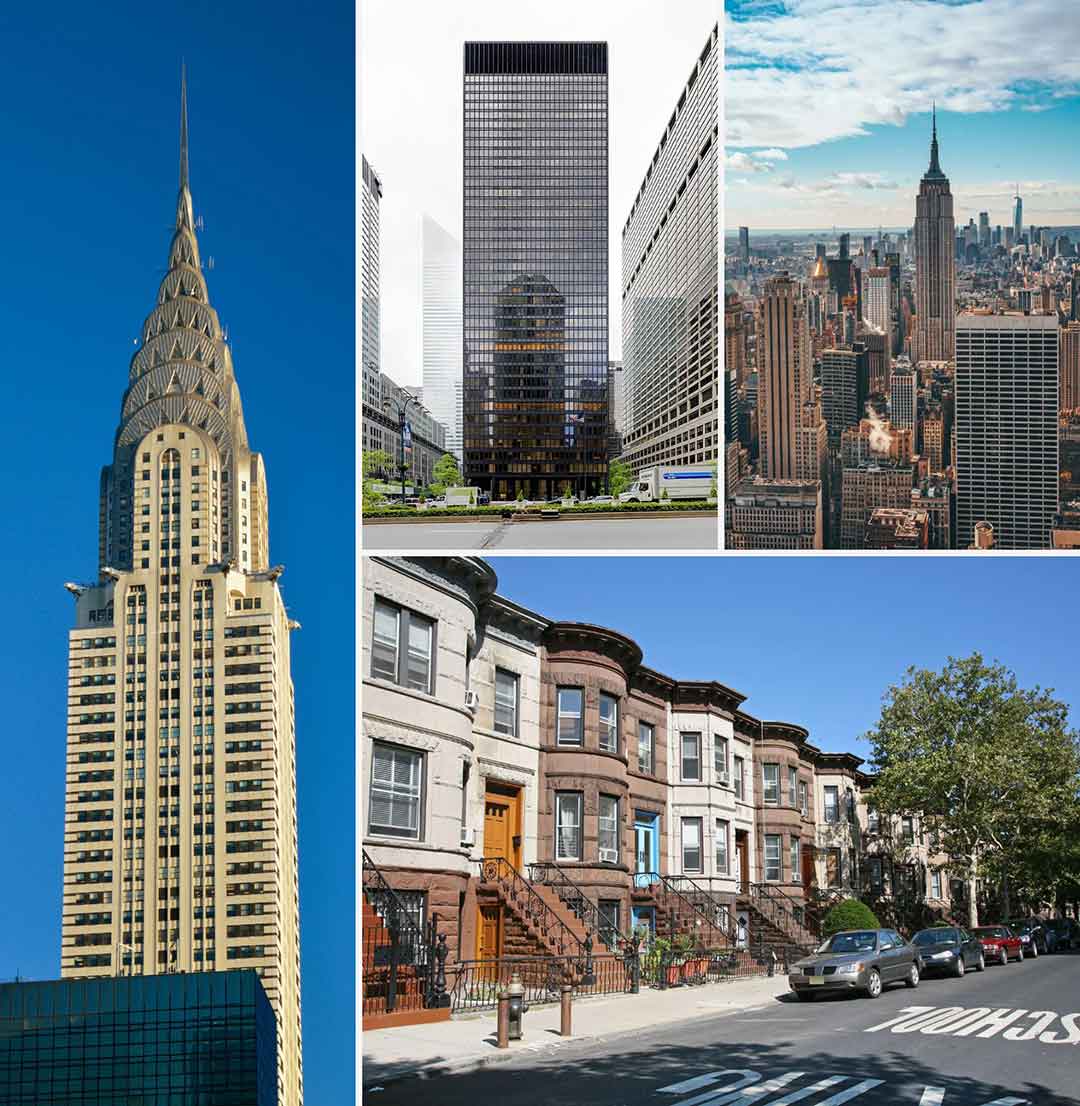
What to know about Paris architecture?
Native Parisians and tourists should know that Paris architecture encompasses opulent styles like Gothic and neoclassical. These styles emphasize grandeur, technological innovation, and religious or historical symbolism. Key examples of Parisian architecture include the Eiffel Tower, the Cathedral of Notre-Dame de Paris, and the Arc de Triomphe. The Notre Dame Cathedral exemplifies French Gothic architecture, illustrating the connection between grandeur, scale, and religious harmony. No single architect is credited for designing the cathedral as it was constructed and modified over centuries, enhancing its detailed composition. The Eiffel Tower by engineer Gustave Eiffel and architects Stephen Sauvestre, Maurice Koechlin, and Émile Nouguier corresponds to the technological leaps triggered by the Second Industrial Revolution. The tower doesn’t align with any specific style, but it represents the ambitious creative efforts of the Parisian Belle Époque period from 1871 to 1914. Conversely, the monument, the Arc de Triomphe by Jean Chalgrin and Louis-Étienne Héricart de Thury, epitomizes Parisian neoclassicism. The structure immortalizes historical events of the French Revolutionary and Napoleonic Wars, which had a significant effect on France’s socio-political structure.
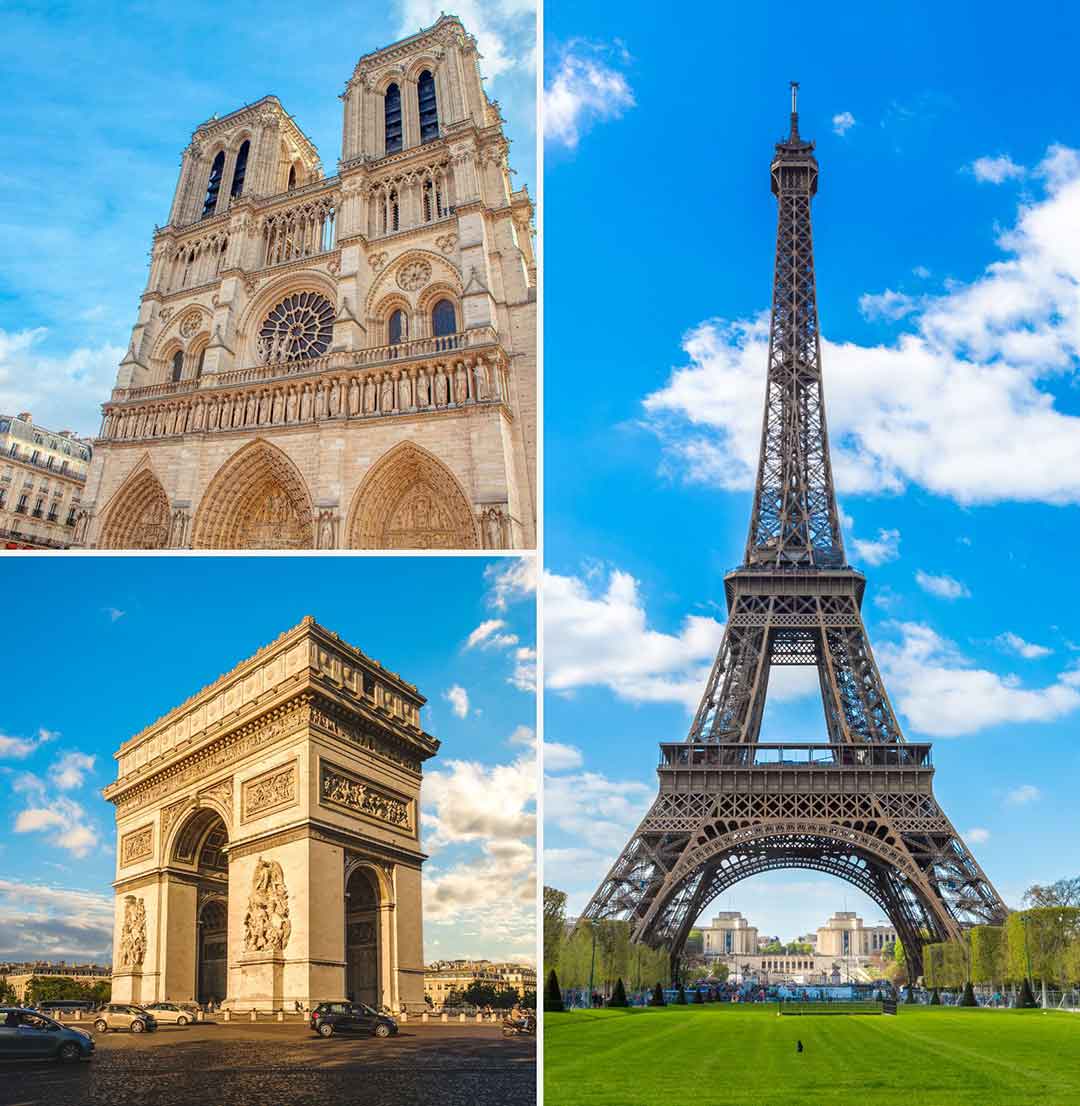
What to know about London architecture?
Individuals should know that London architecture is a diverse landscape defined by different historical periods. Consequently, notable structures in London range from Gothic, regency, and baroque to modern and postmodernism. Older landmarks in London survived or were revived following major fires and World War II. For instance, the Palace of Westminster by architects Charles Barry and Augustus Pugin is a long-standing national symbol and a key example of the city’s Gothic elements. The palace was largely destroyed by a fire in 1834 and suffered damage under air raids in 1940 and 1941, respectively, but was restored and renovated. Other landmarks like the regency-styled Park Crescent by John Nash denote the white stucco facades, columns, and symmetry of the late Georgian era. Meanwhile, more contemporary buildings dot the London skyline, namely the postmodern Gherkin by the Foster and Partners firm. The Gherkin illustrates how London architecture in the early 2000s pushed for experimentation to reinvent the cityscape and create iconic landmarks to juxtapose older time periods.

What to know about Liverpool architecture?
Key facts to know about Liverpool architecture reflect the historical influence of English architectural movements. The cityscape of Liverpool is distinctively English as it’s governed by Victorian, Edwardian, and Georgian architecture. For example, the Royal Albert Dock by architects Jesse Hartley and Philip Hardwick is a well-known landmark. The dock exemplifies classic Victorian workhouses through its stark symmetry and brick, sandstone, and granite facade. Meanwhile, the Royal Liver Building by Walter Aubrey Thomas characterizes the opulence and innovation of the Edwardian period through its blend of styles and usage of reinforced concrete. However, a third landmark, the New Hall Place by the Tripe & Wakeham firm, departs from traditional English architecture. The structure employs brutalist elements, resulting in a contrast between the historical structures of Liverpool and the contemporary trajectory of the cityscape. These architectural juxtapositions create a distinction between the influence of English movements and the city’s respective architectural direction.
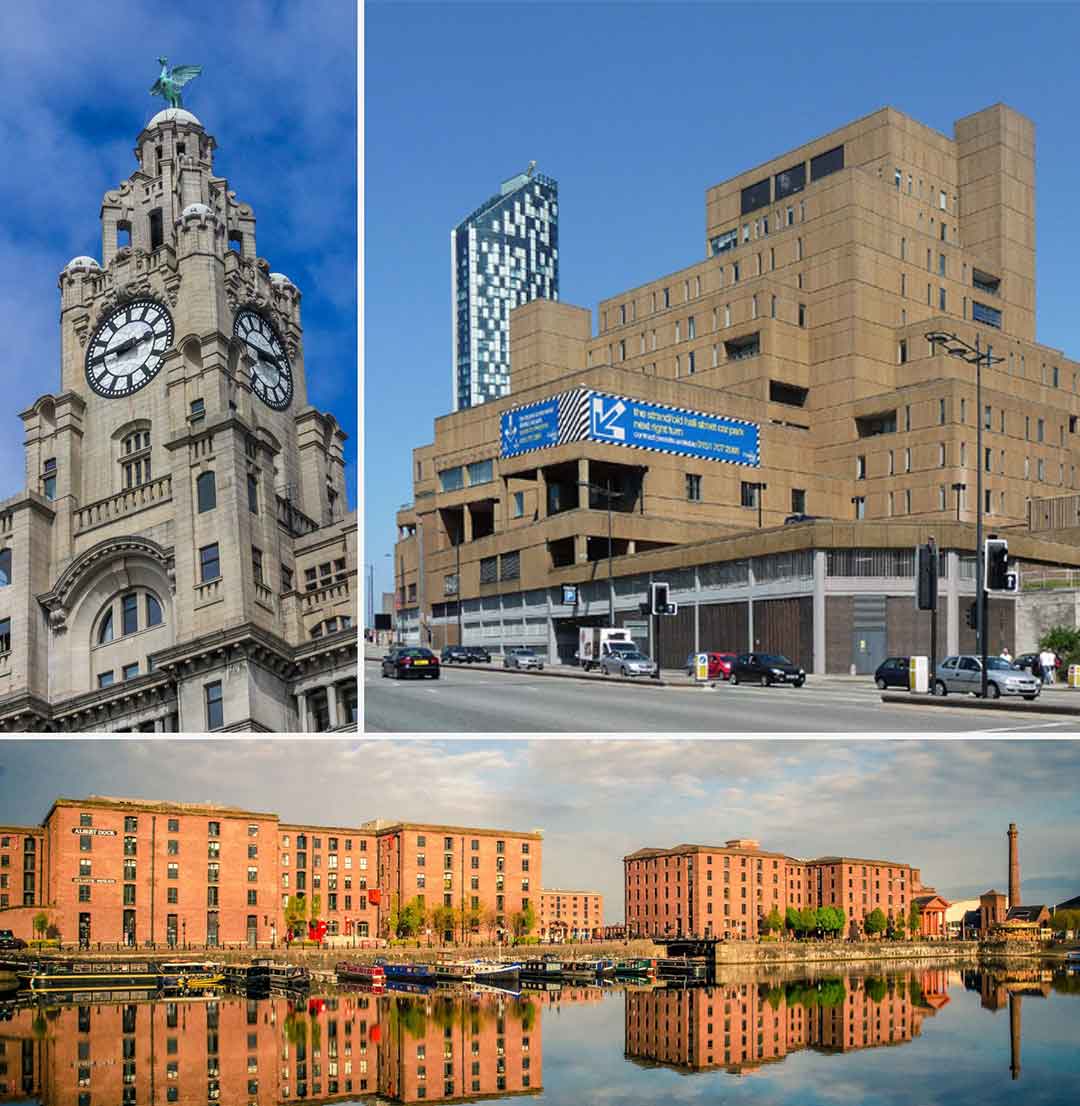
What to know about Mexico City architecture?
Facts about Mexico City’s architecture primarily reflect a combination of Mesoamerican and European architectural styles. Older landmarks in Mexico City emphasize European influences, such as Baroque, Neoclassical, Art Nouveau, and Art Deco. For instance, the Mexico City Metropolitan Cathedral took 240 years to build and consequently exemplifies various architectural movements that inspired the different architects who worked on the structure, such as Claudio de Arciniega and Manuel Tolsá. The cathedral features fundamental elements of Gothic churches while imposing Baroque and Plateresque aesthetics among other styles. Additionally, the building retains a distinctly Mesoamerican facade through its focus on Mexican catholicism and national symbolism. Meanwhile, the Palacio de Bellas Artes is another structure in Mexico City that demonstrates European styles. The structure was helmed by different architects, similar to the Metropolitan Cathedral, with Adamo Boari and Ggéza Maróti listed among its designers. The exterior illustrates the symmetry, curved lines, and grandeur associated with Neoclassicism and Art Nouveau with the former being more predominant. Conversely, the interior displays Art Deco influences merged with indigenous aesthetics and patriotic symbology. Mexico City’s most distinguished architecture consequently exhibits historically European styles, though contemporary structures diverge in this aspect by being more experimental. For example, the Liverpool Insurgentes department store by Rojkind Arquitectos was built in 2014 and displays a parametric and postmodern facade that emphasizes geometric shapes—distinguishing itself among the historical buildings.
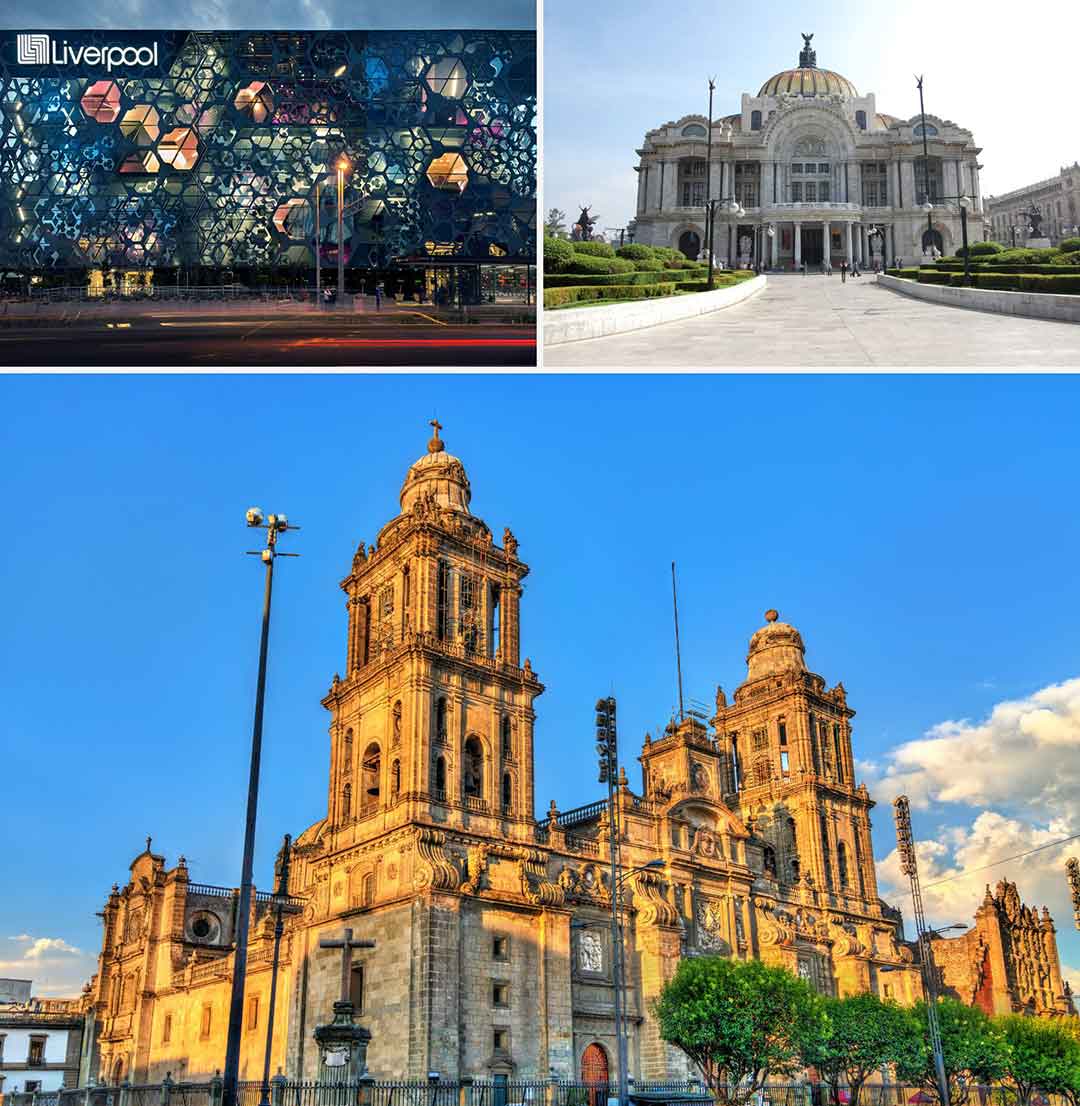
What to know about Istanbul architecture?
Visitors and inhabitants should know that Istanbul architecture is primarily hallmarked by Byzantine and Ottoman styles. Istanbul was the centerpiece of the Byzantine and Ottoman empires and consequently illustrates classical architecture from both time periods. For instance, the Hagia Sophia by architects Isidore of Miletus and Anthemius of Tralles is an example of peak Byzantine engineering. The structure initially served as a church and later as a mosque, capturing the highly detailed interiors, massive domes, and elaborate motifs associated with Byzantium religious structures. Meanwhile, the Blue Mosque (officially called the Sultan Ahmed Mosque) exemplifies Ottoman architecture, which was influenced by the Byzantine Empire. The mosque features domes, a blue and white color palette, and hand-painted ceramics unique to Ottoman craftsmanship. That said, not all landmarks in Istanbul are Byzantine or Ottoman. For example, the Galata Tower by an unknown architect expresses Genoese influences. The 205-foot-high structure additionally features a mixture of Romanesque architecture due to its cylindrical shape and defensive layout, functioning as a watchtower for a Genoese colony that inhabited the Beyoğlu district in Istanbul, Turkey.
